By: Team T12-1 Since: Feb 2019 Licence: MIT
1. Introducing HMS+
You need a world-class property management system to run your hotel’s front desk and back office. We’ve spent years listening to what independent hoteliers need to take their business to the next level. From before check-in to post check out, we have everything you need to get your customers moving and your hotel running.
HMS+ is for hotels that want to use a single, integrated system to manage all aspects of their requirements.
This user guide provides an in-depth documentation on the HMS+ installation process, system configuration and management, monitoring and troubleshooting problems. In addition, the Section 2, “Getting Started” will provide the basic knowledge of the setup process and how you can get started.
2. Getting Started
-
Ensure you have Java version
9or later installed in your Computer. -
Download the latest
hms+.jarhere. -
Copy the file to the folder you want to use as the home folder for your Hotel Management System Plus.
-
Double-click the file to start the app. The application should appear in a few seconds.

-
Type the command in the command box and press Enter to execute it.
e.g. typinghelpand pressing Enter will open the help window. -
Some example commands you can try:
-
list-customers: lists all customers -
add-customern/John Doe p/98765432 e/johnd@example.com id/G8957685R a/John street, block 123, #01-01: adds a customer namedJohn Doeto the HMS+ database. -
delete-customer3: deletes the 3rd customer shown in the current list -
exit: exits the app
-
-
Refer to Section 3, “Features” for details of each command.
3. Features
Command Format
-
Words in
UPPER_CASEare the parameters to be supplied by the user. For example, inadd n/NAME,NAMEis a parameter which can be used asadd n/John Doe. -
Items in square brackets are optional. For example,
n/NAME [t/TAG]can be used asn/John Doe t/friendor asn/John Doe. -
Items in curly brackets separated by a slash (
/) are interchangeable (entering either of those items have the same effect). For example,{addcustomer/ac}are two aliases of the same command. -
Items with
…after them can be used multiple times including zero times. For example,[t/TAG]…can be used ast/friend,t/friend t/familyetc. -
Parameters can be in any order. For example, if the command specifies
n/NAME p/PHONE_NUMBER,p/PHONE_NUMBER n/NAMEis also acceptable. -
If you enter the same prefix twice, the data in the second prefix is recorded. For example,
n/Tejas Bhuwania n/Sanjay Bhuwaniawill take in Sanjay Bhuwania inside the database. -
All commands using indexes refer to the displayed list. For example, if the displayed customer list has 2 customers and you try to delete customer at index 3, it is an invalid command, though there are total of five customers in the database.
|
The examples for each of the commands given below are independent of each other and do not follow a chronological order. |
3.1. Viewing help : help,hp
Effect: Displays a help list, which lists all the commands that can be used.
Format: {help/hp}
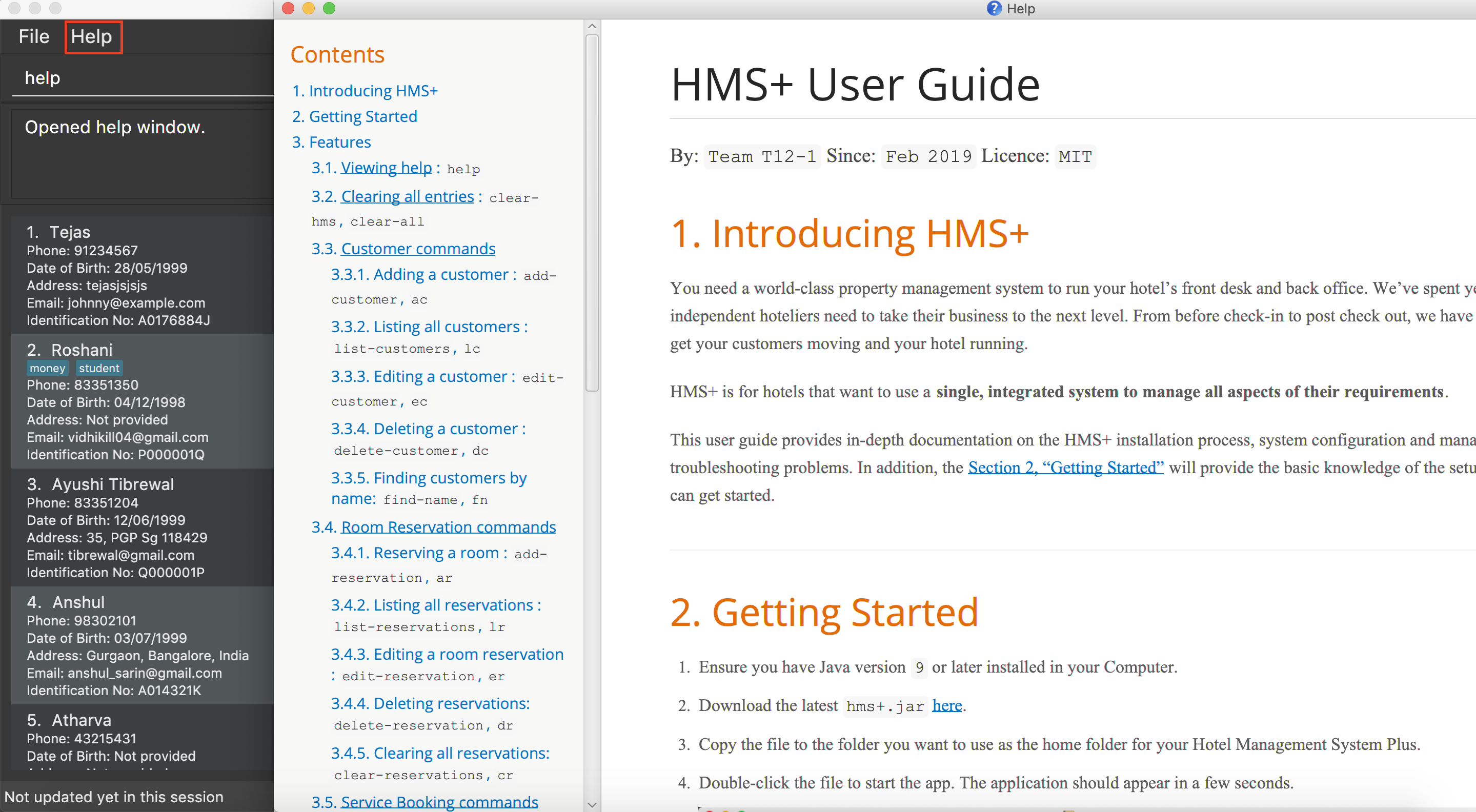
help command3.2. Customer commands
3.2.1. Adding a customer : add-customer, ac
Effect: Adds a customer to the customer database.
Format: {add-customer/ac} n/ NAME p/ PHONE_NUMBER e/ EMAIL id/ IDENTIFICATION_NO [ dob/ DATE_OF_BIRTH ] [ a/ ADDRESS ] [ t/ TAG ]
|
| A person can have any number of tags (including 0) |
Examples:
-
ac n/John Doe p/98765432 dob/28/05/1999 e/johnd@example.com id/A5525261 a/John street, block 123, #01-01 t/StudentAdds the customer John Doe with the given details.
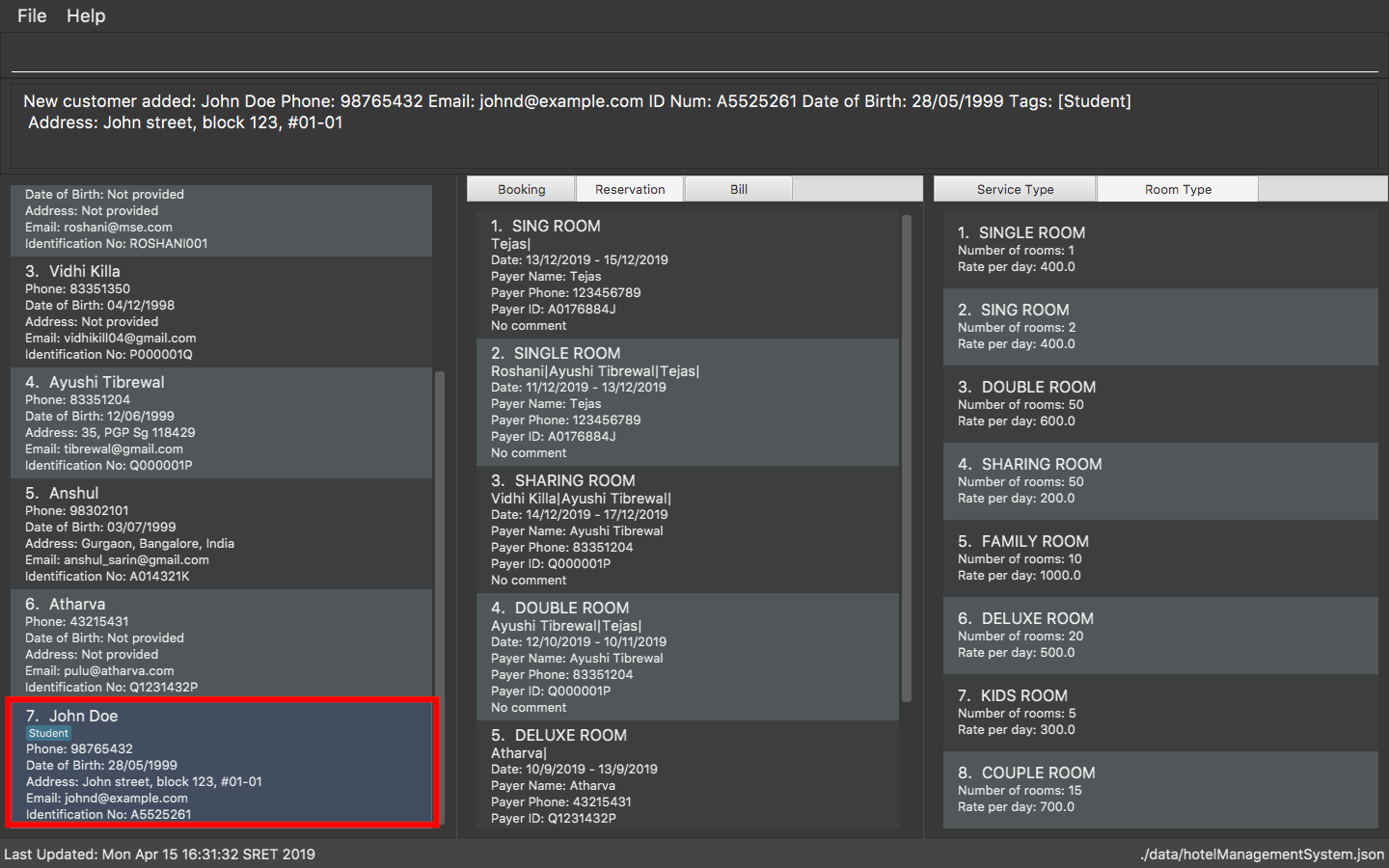
-
ac n/Betsy Crowe e/betsy.crowe@example.com p/98321012 id/A3452521QAdds the customer Betsy Crowe with the given details.
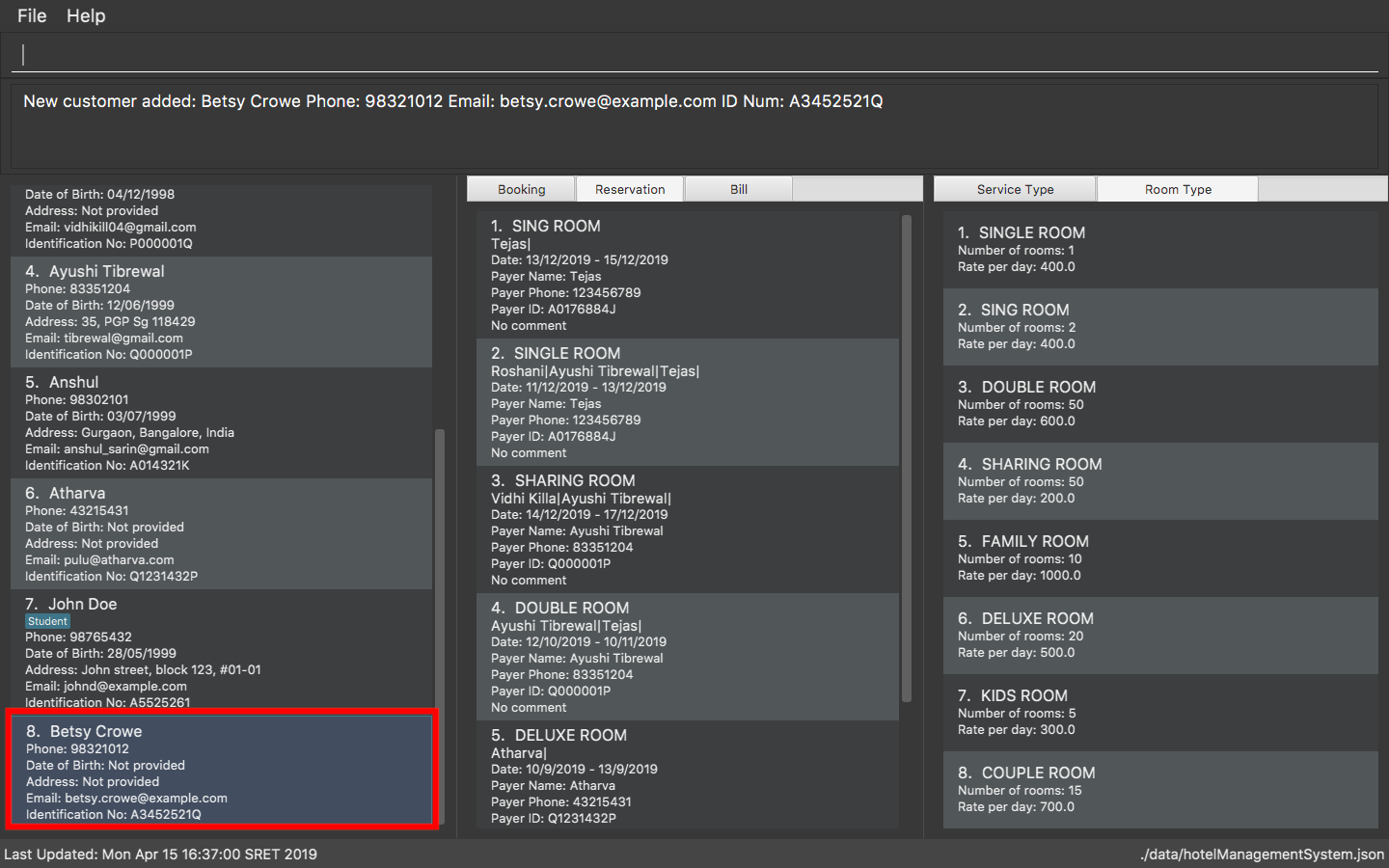
add-customer command3.2.2. Listing all customers : list-customers, lc
Effect: Displays a customer list, which lists all customers in the customer database.
Format: {list-customers/lc}
Examples:
-
lc
Lists all the customers present in the database.

lc command3.2.3. Editing a customer : edit-customer, ec
Effect: Edits the fields of an existing customer in the customer database.
Format: {edit-customer/ec} INDEX [ n/ NAME ] [ p/ PHONE ] [ e/ EMAIL ] [ id/ IDENTIFICATION_NO ] [ dob/ DATE_OF_BIRTH ] [ a/ ADDRESS ] [ t/ TAG…]
|
You can remove all the customer’s tags by typing t/ without specifying any tags after it.
|
Examples:
-
lc, thenec 2 n/Roshani Venkatesh t/
Edits the name of the 2nd customer to beRoshani Venkateshand clears all existing tags.

ec command
ec command3.2.4. Finding customers by name: find-name, fn
Effect: Displays a customer list, which consists of customers whose names contain any of the given keywords.
Format: {find-name/fn} KEYWORD [ MORE_KEYWORDS ]
|
Examples:
-
find-name Vidhi
Returns any person having nameVidhi.

find-name Vidhi command-
fn Tejas Vidhi Ayushi
Returns any person having namesTejas,VidhiandAyushi.
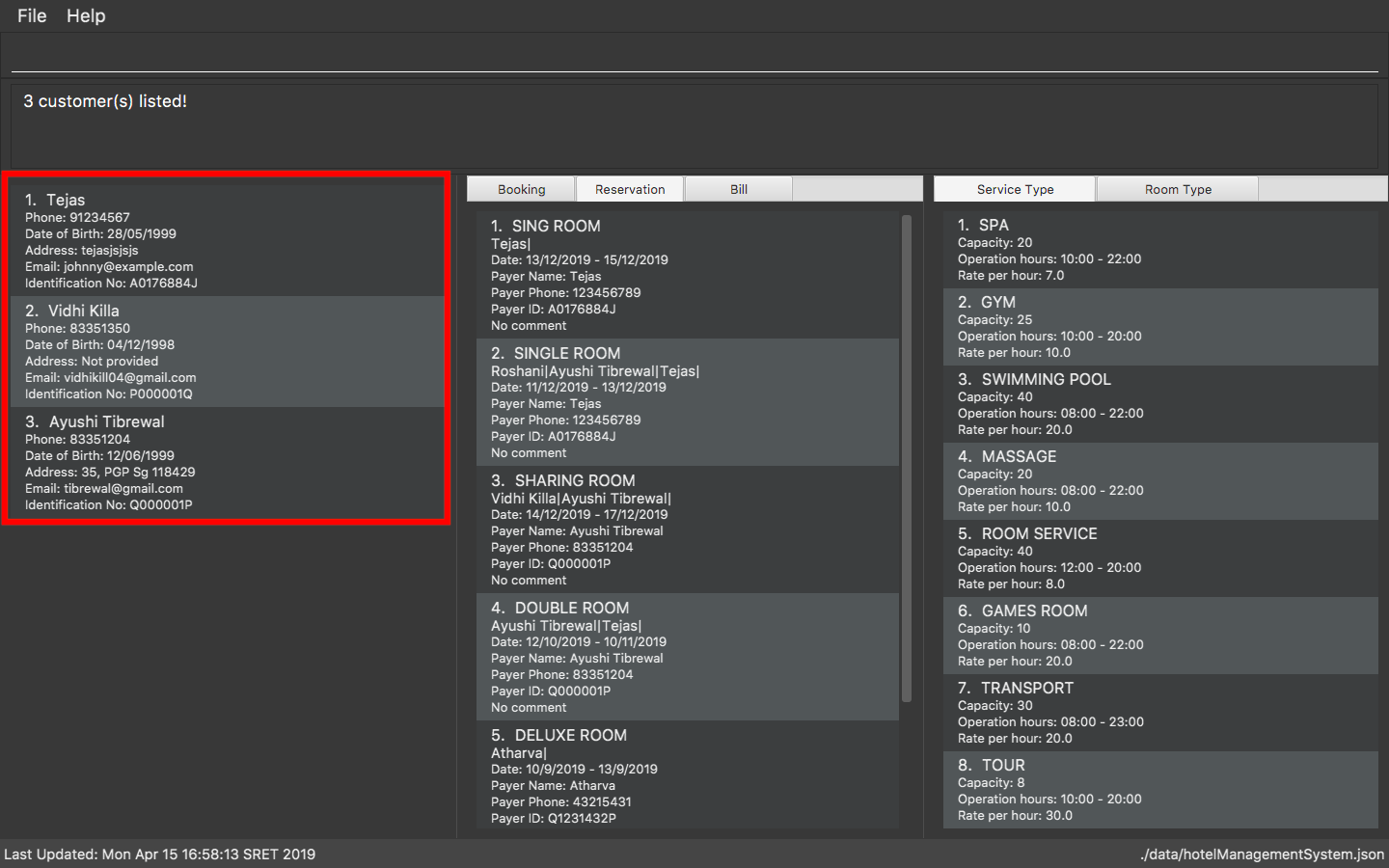
fn Tejas Vidhi Ayushi command3.2.5. Deleting a customer : delete-customer, dc
Effect: Deletes a customer from the customer database.
Format: {delete-customer/dc} INDEX
|
Examples:
-
list-customers, thendelete-customer 2
Deletes the 2nd person of the customer database.
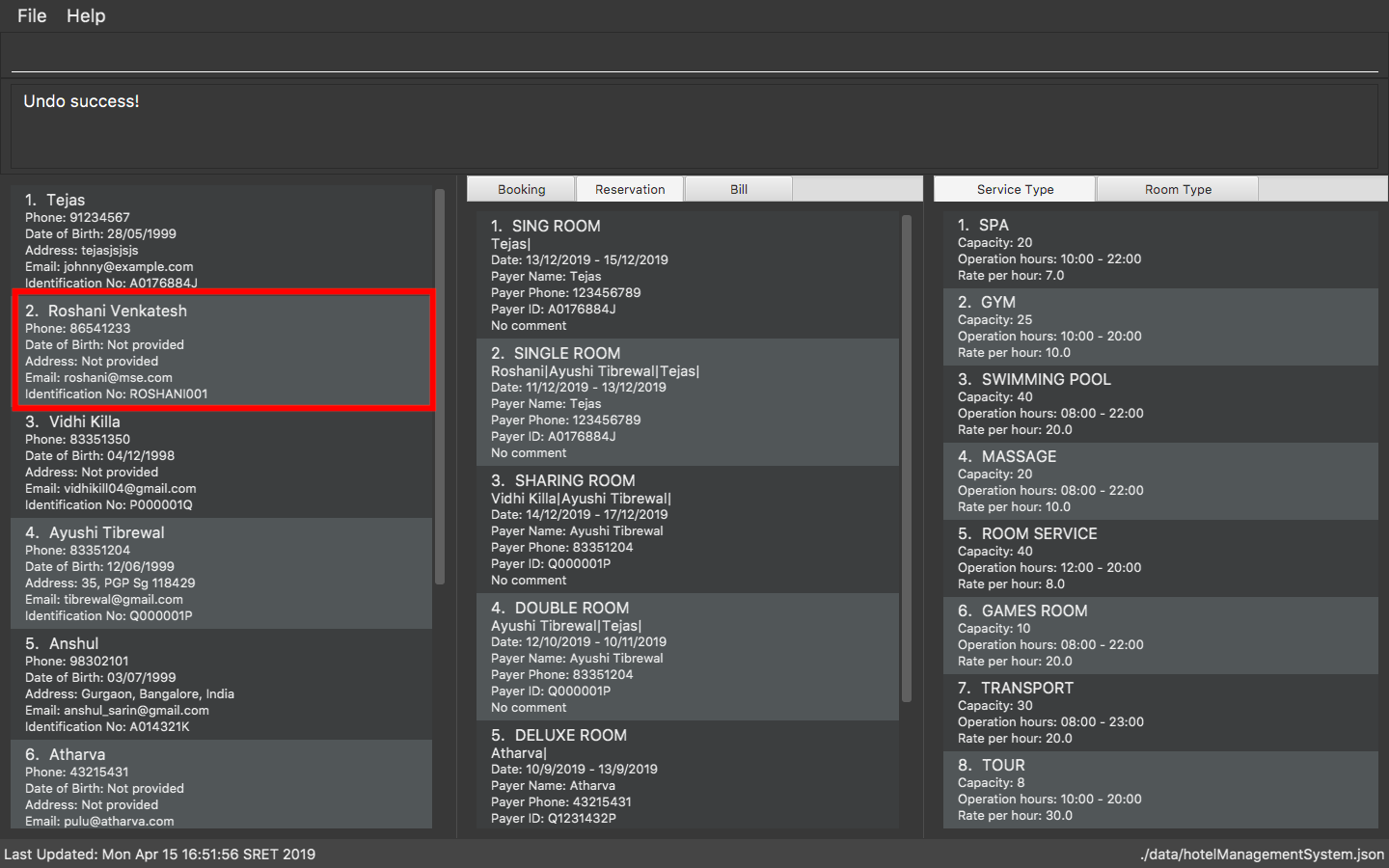
delete-customer 2 command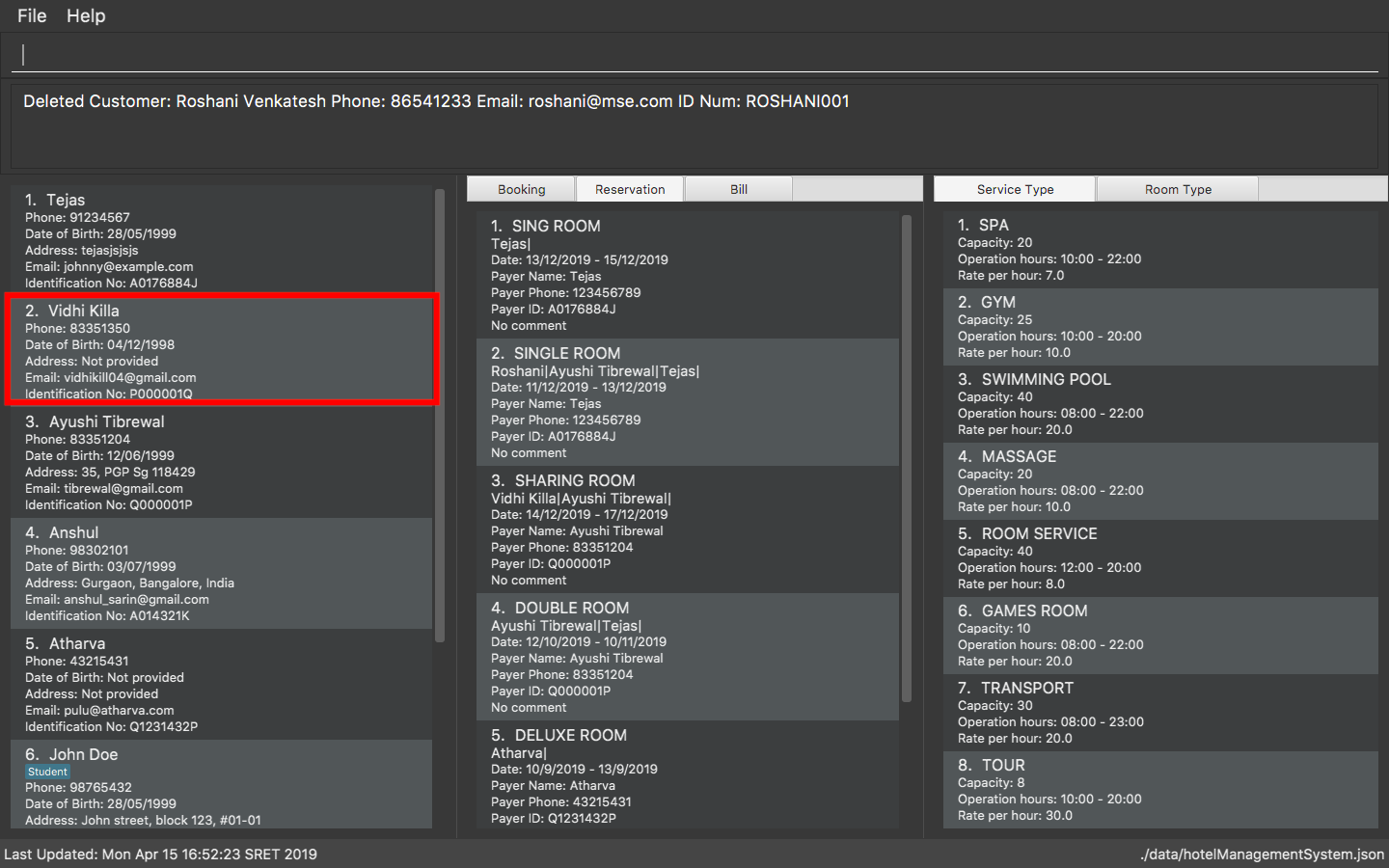
delete-customer 2 command-
find-name Betsy Tejas, thendelete-customer 2
Deletes the 2st customer in the customer list returned by thefind-namecommand.
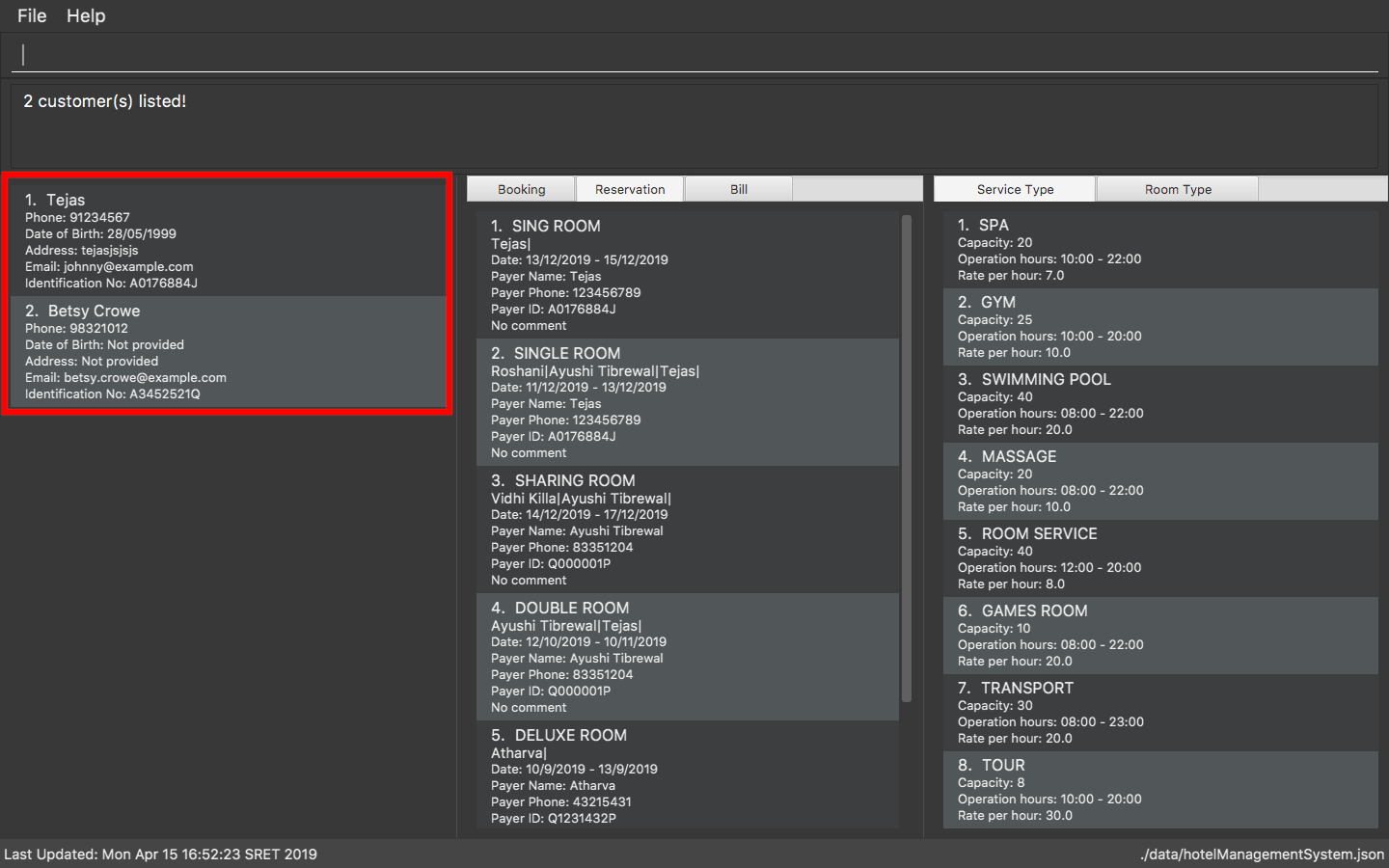
find-name Betsy Tejas command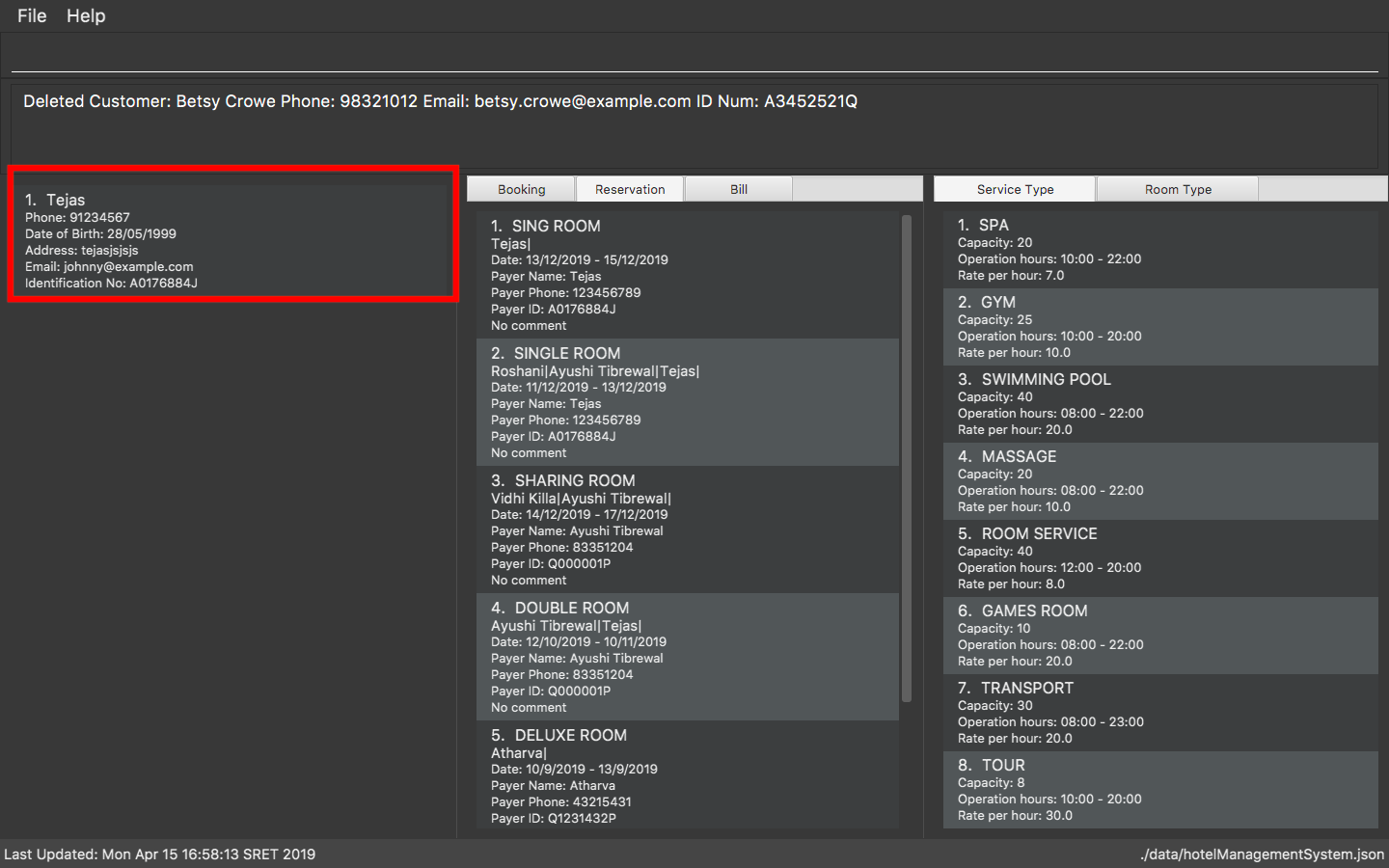
delete-customer 2 command3.3. Room Type commands
3.3.1. Adding a room type : add-room-type, art
Effect: Adds a room type to hotel database. This makes it available for people to do reservations with the added room type.
Format: {add-room-type/art} n/ ROOM_TYPE cap/ NUMBER_OF_ROOM rate/ RATE
|
|
Example:
-
art n/FUN ROOM cap/50 rate/300.0
Adds a room type with name FUN ROOM, with a rate of 300.0 and capacity of 50
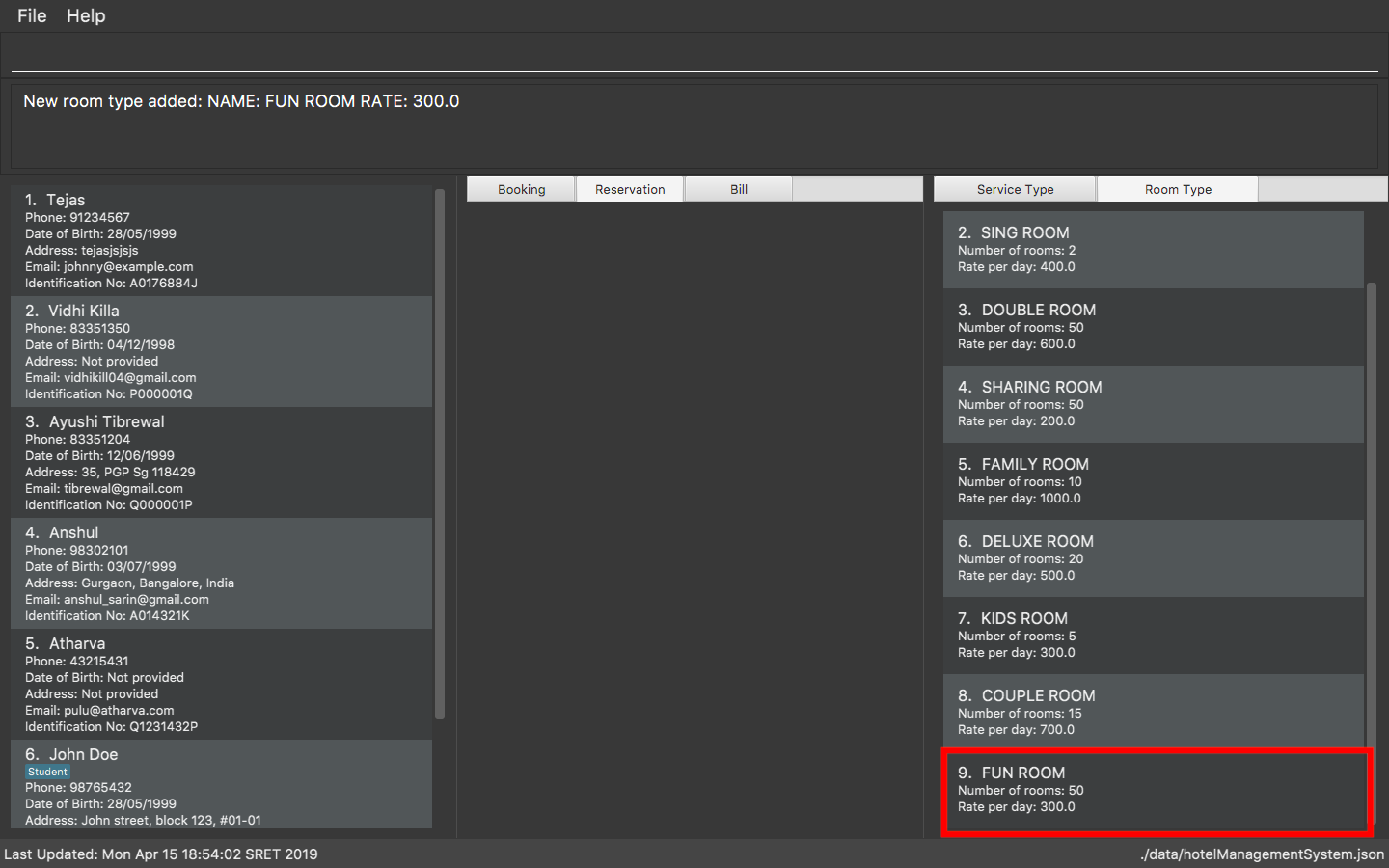
art n/FUN ROOM cap/50 rate/300.0 command3.3.2. Deleting a room type : delete-room-type, drt
Effect: Deletes a room type from the hotel database. This makes it unavailable for people to do reservations with the deleted room type.
Format: `{delete-room-type/drt} INDEX
|
Deleting a room type also deletes all its related reservations. |
Example:
-
drt 2
Deletes the room type at index 2.
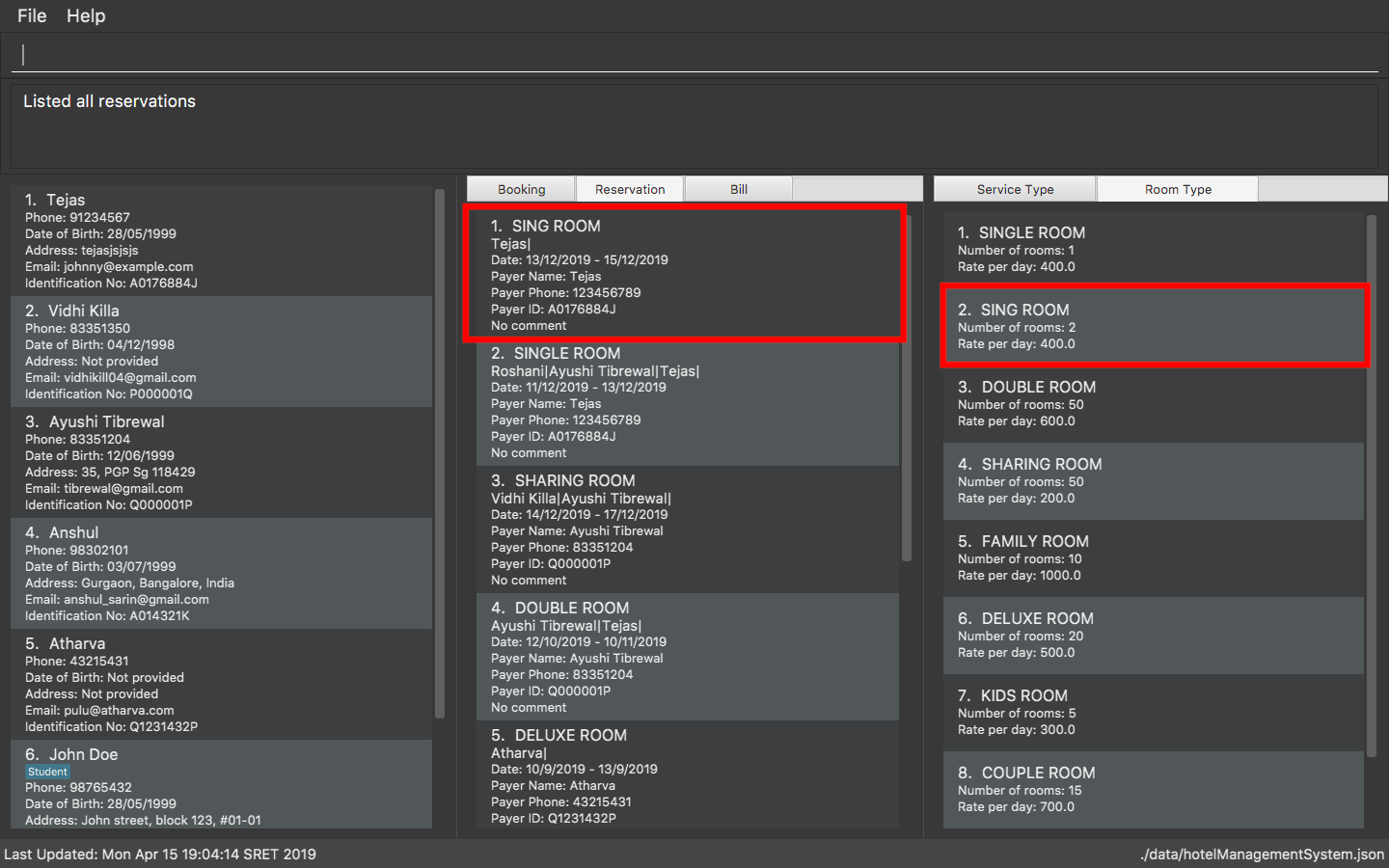
drt 2 command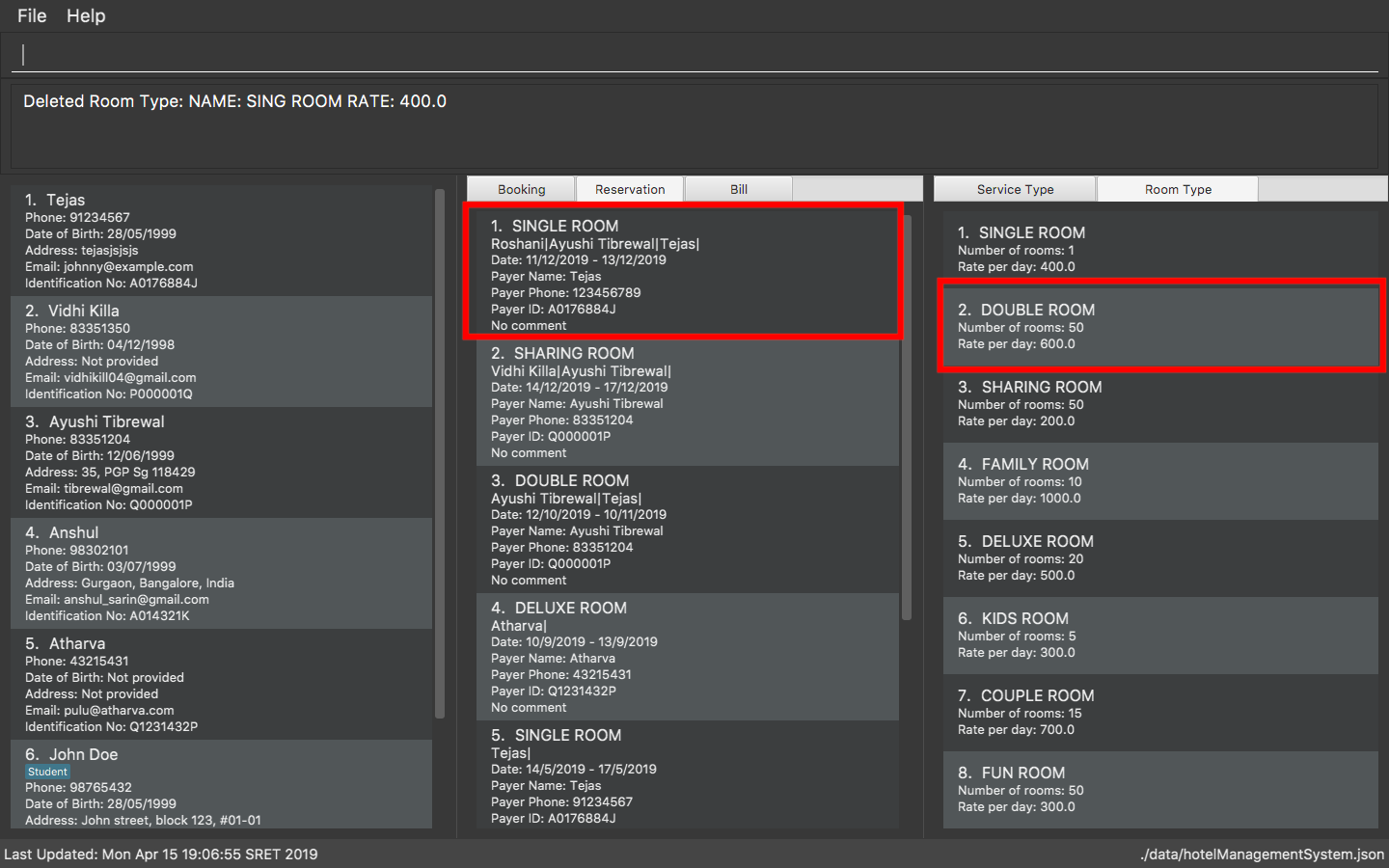
drt 2 command3.3.3. Clearing all room types: clear-room-type, crt
Effect: Removes all room types and room reservations from the database.
Format: {clear-room-type/crt}
Examples:
-
crt
Clears all room types and reservations from the database.
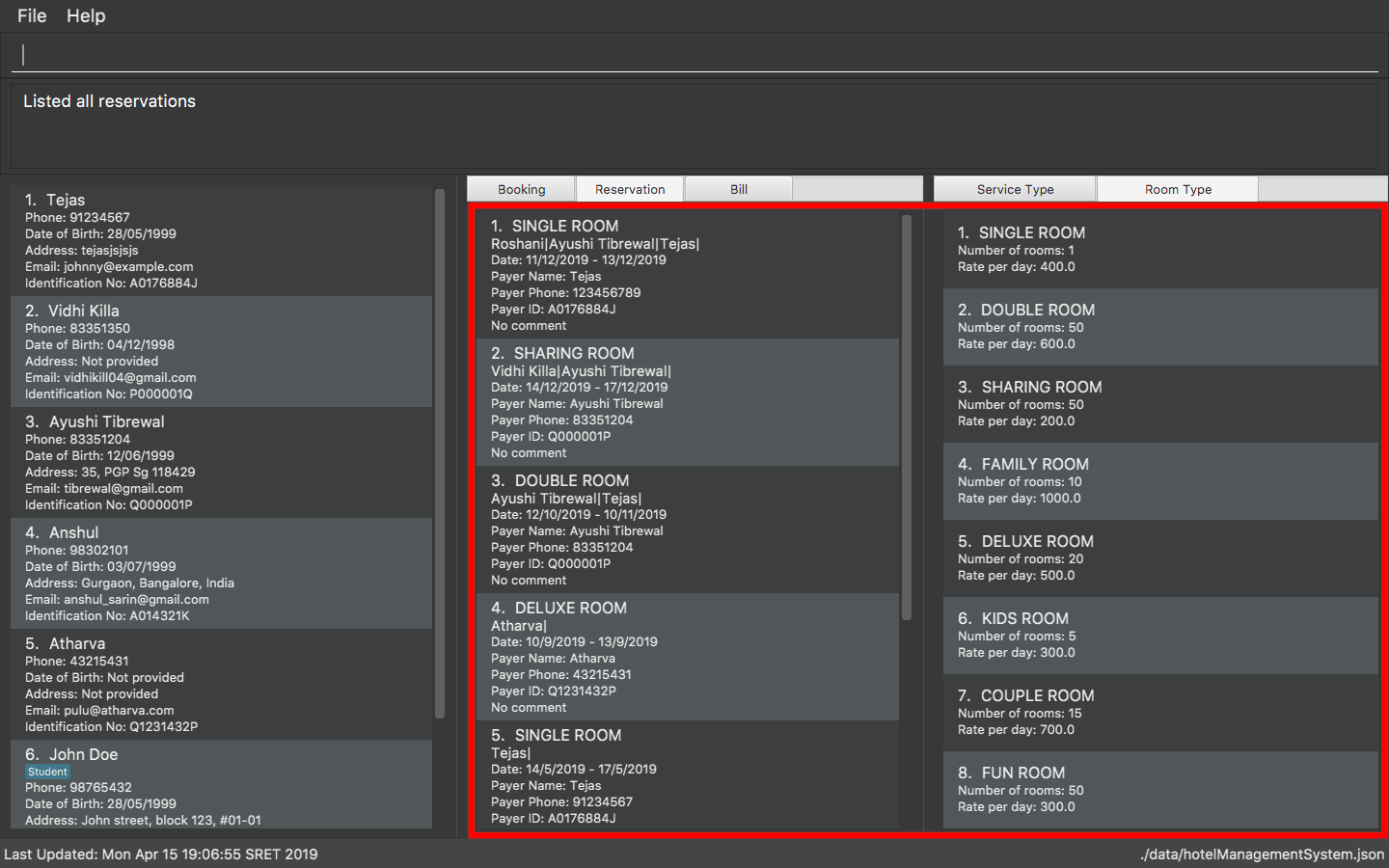
crt command
crt command3.3.4. Editing a room type : edit-room-type, ert
Effect: Edits the room type at the specified index. This modifies the room available to people to do reservations.
Format: {edit-room-type/ert} INDEX [ n/ ROOM_TYPE ] [ cap/ NUMBER_OF_HOURS ] [ rate/ RATE ]
Example:
-
ert 2 cap/100
Edits the room type at index 2 by changing the number of rooms to 100.
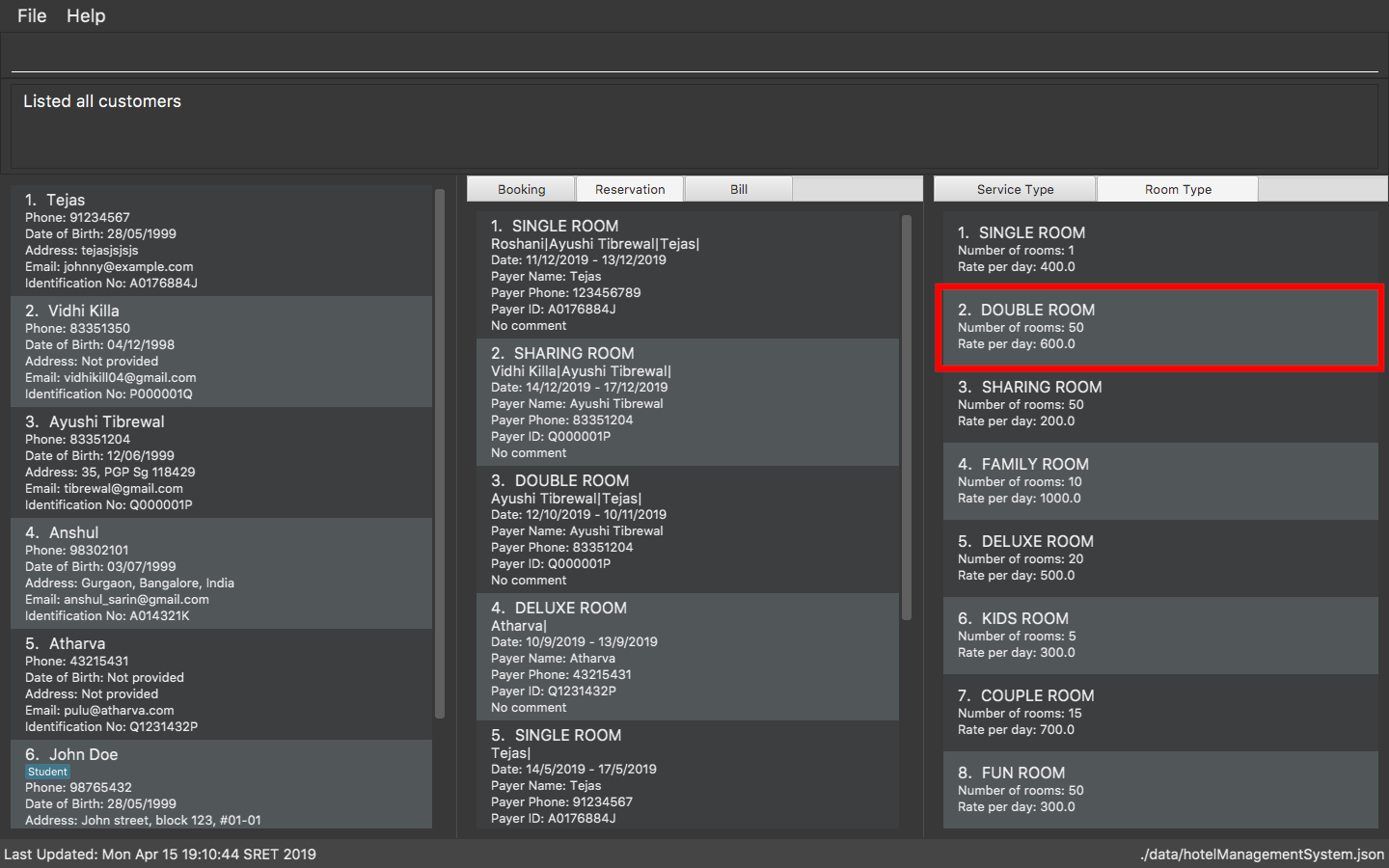
ert 2 cap/100 command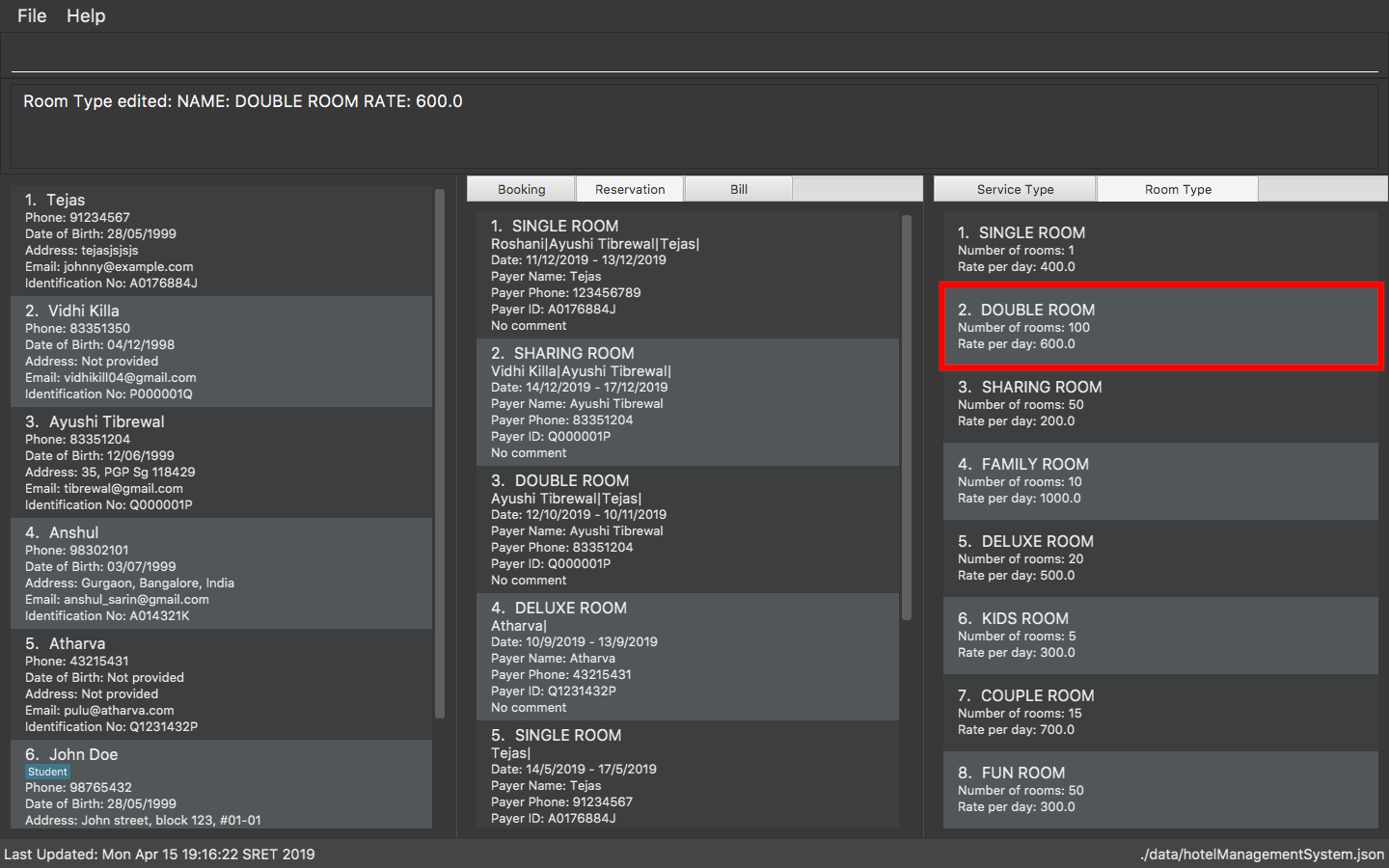
ert 2 cap/100 command3.4. Room Reservation commands
3.4.1. Reserving a room : add-reservation, ar
Effect: Adds a reservation for a room associated with certain customers.
Format: {add-reservation/ar} r/ ROOM_TYPE d/ START_DATE-END_DATE $/ PAYER_INDEX [ c/ MORE_CUSTOMER_INDICIES… ] [ com/ COMMENTS ]
|
Examples:
Assume current date is 10 May, 2019.
-
list-customers, thenar r/SINGLE ROOM d/20/5/2019-25/5/2019 $/5
Adds a reservation of Single Room in the name of the 5th customer from 20 May 2019 to 25 May 2019.
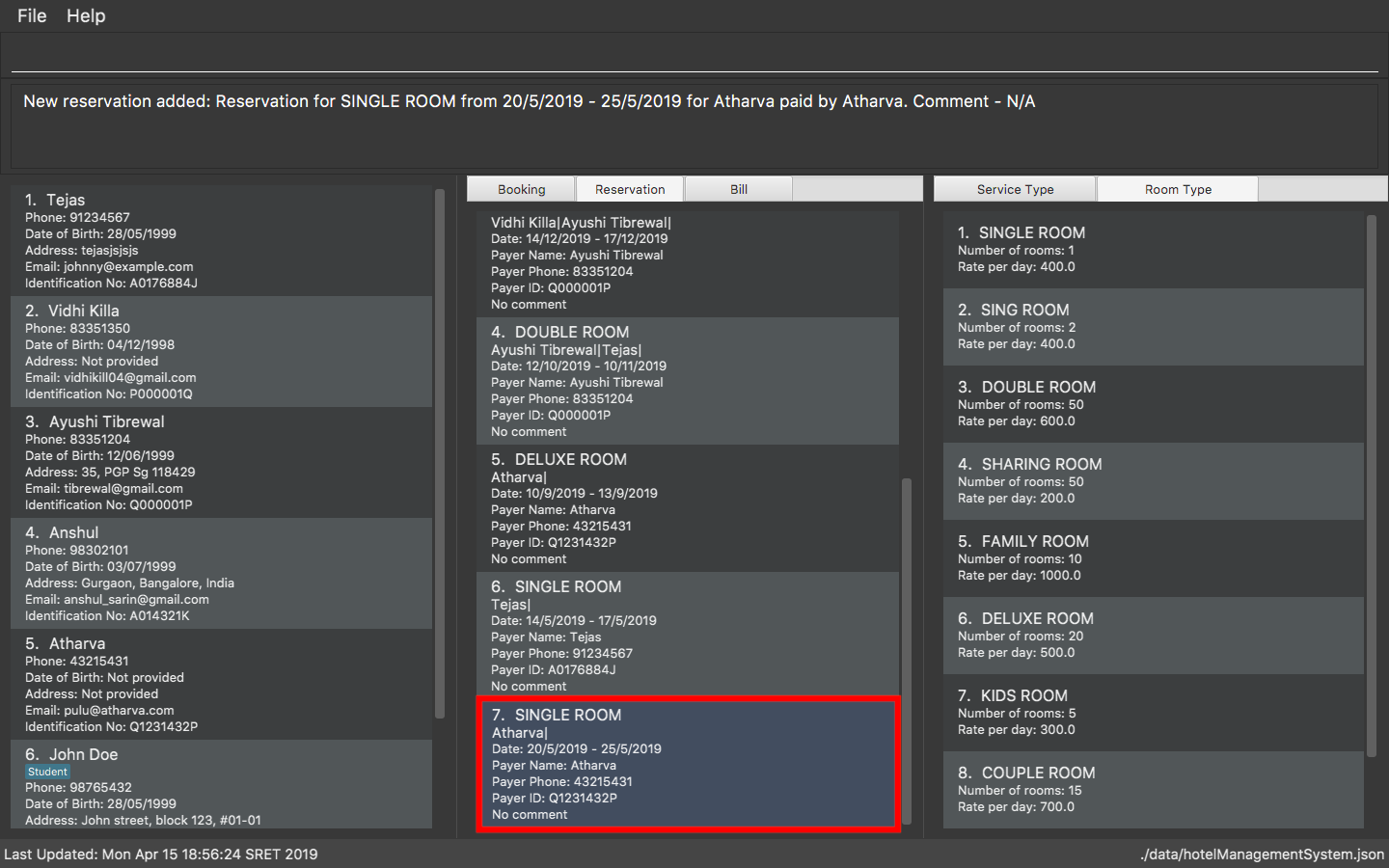
above command-
list-customers, thenar r/SHARING ROOM d/23/5/2019-25/5/2019 $/4 c/2 c/3
Adds a reservation of Sharing Room in the name of the 4th customer along with the 2nd and 3rd customers from 23 May 2019 to 25 May 2019.
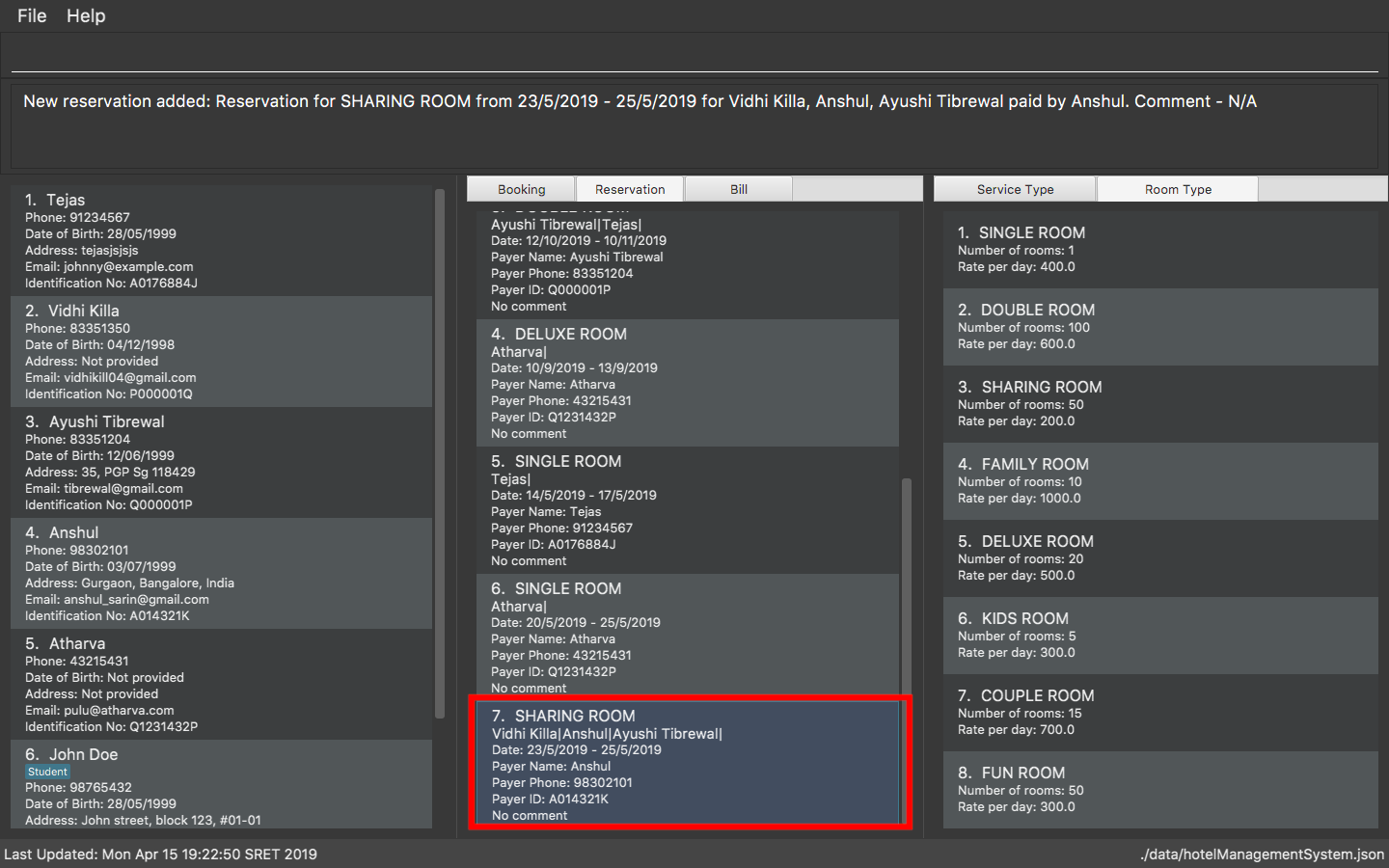
above command3.4.2. Listing all reservations : list-reservations, lr
Effect: Displays a reservation list, which lists all the reservations.
Format: {list-reservations/lr}
Examples:
-
lr
Lists all reservations.

lr command3.4.3. Editing a room reservation : edit-reservation, er
Effect: Edits the fields of an existing reservation in the reservation database.
Format: {edit-reservation/er} INDEX [ r/ ROOM_TYPE ] [ d/ START_DATE-END_DATE] ] [ $/ PAYER_INDEX ] [ c/ MORE_CUSTOMER_INDICES ] [ com/ COMMENTS ]
|
You can remove all the reservation’s comments by typing com/ without specifying any tags after it.
|
Examples:
-
lr, thener 1 r/DOUBLE ROOM
Edits the room type of the 1st reservation to be DOUBLE ROOM.
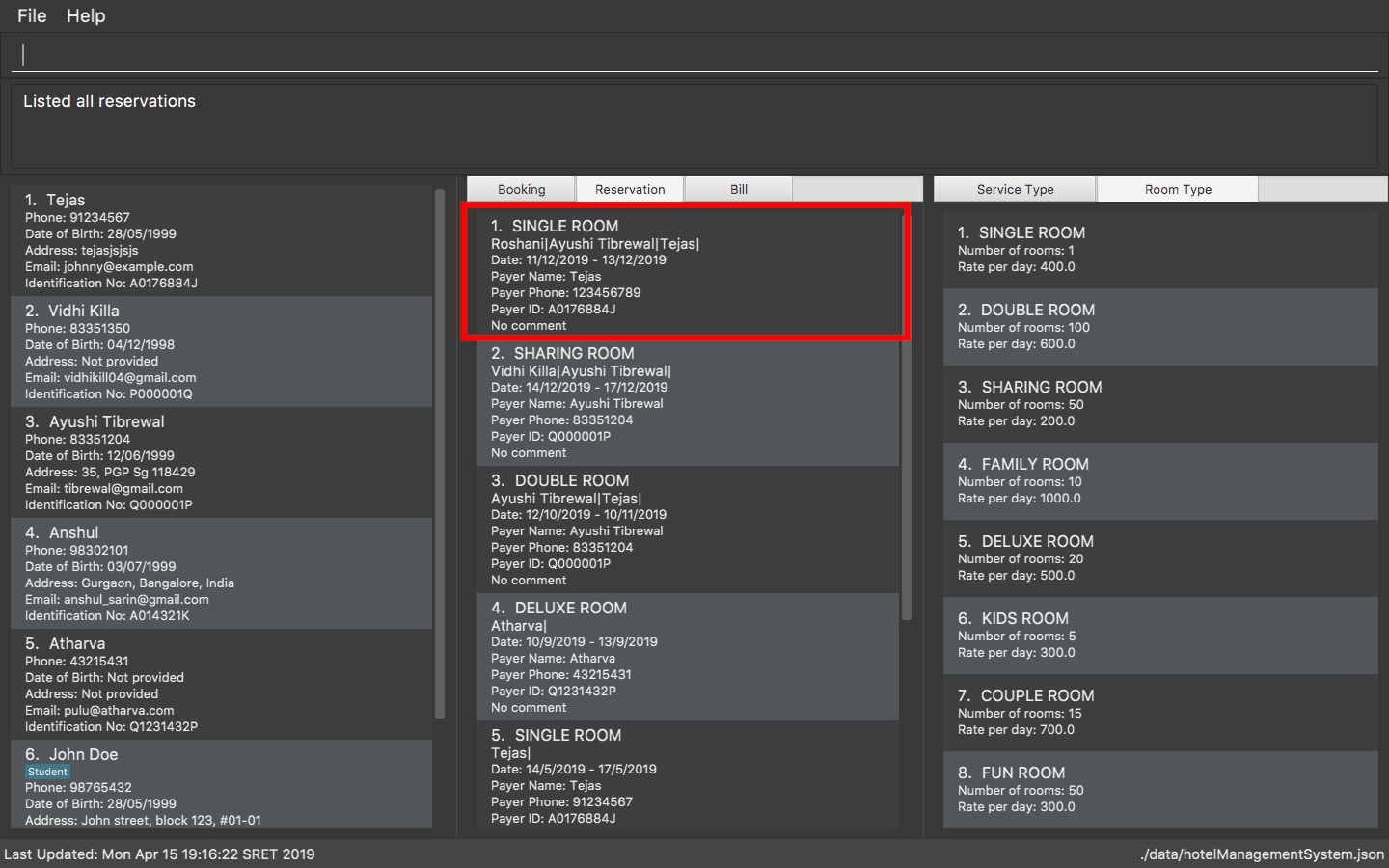
er 1 r/DOUBLE ROOM command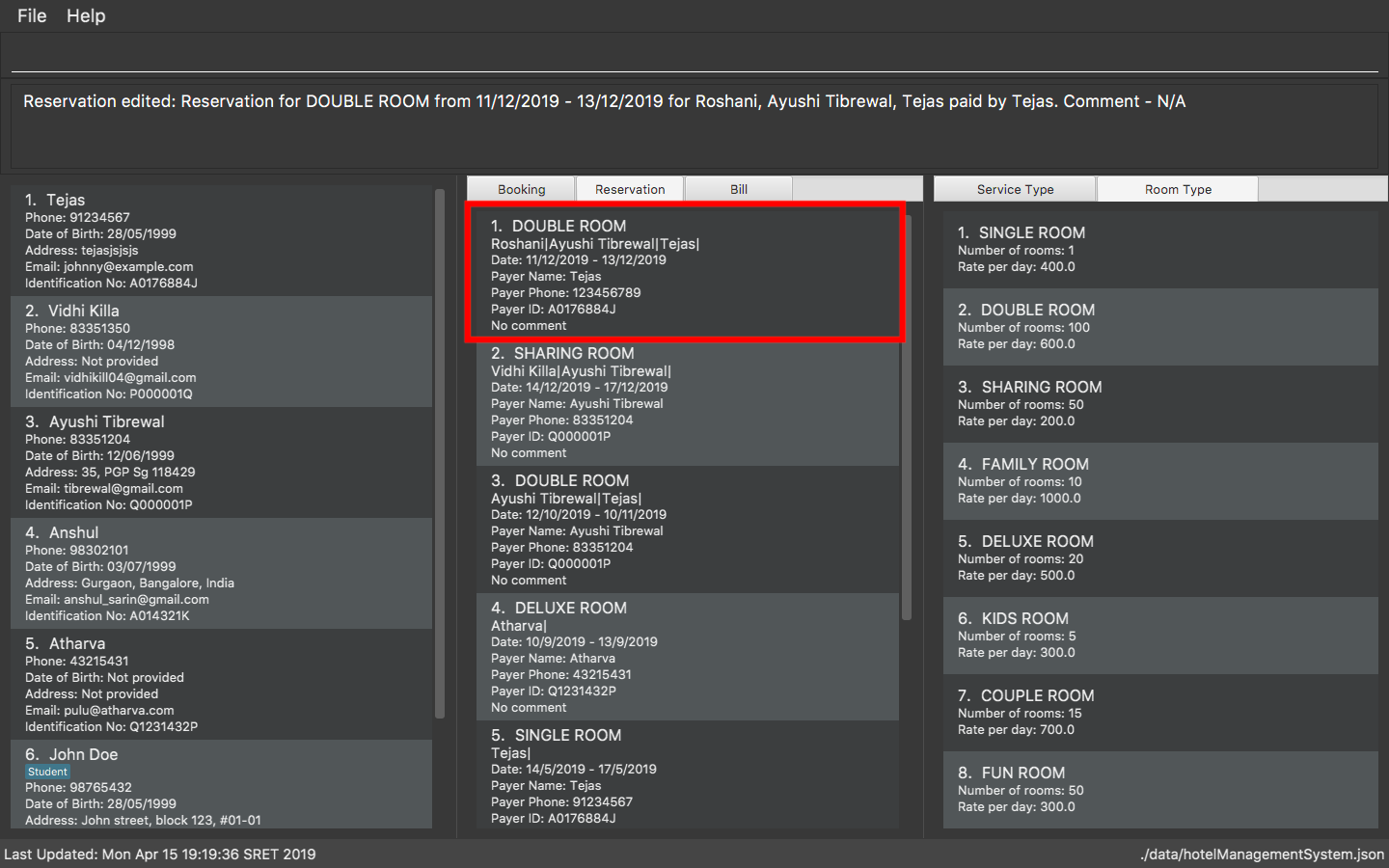
er 1 r/DOUBLE ROOM command-
lr, thener 2 d/14/02/2020-14/03/2020 com/
Edits the date of the 2nd reservation to be from 14 Feb 2020 to 14 Mar 2020 and clears all existing comments related to it.
3.4.4. Deleting reservations: delete-reservation, dr
Effect: Deletes a reservation from the reservation database.
Format: {delete-reservation/dr} INDEX
Examples:
-
lr, thendr 2
Deletes the 2nd entry of the reservation database.
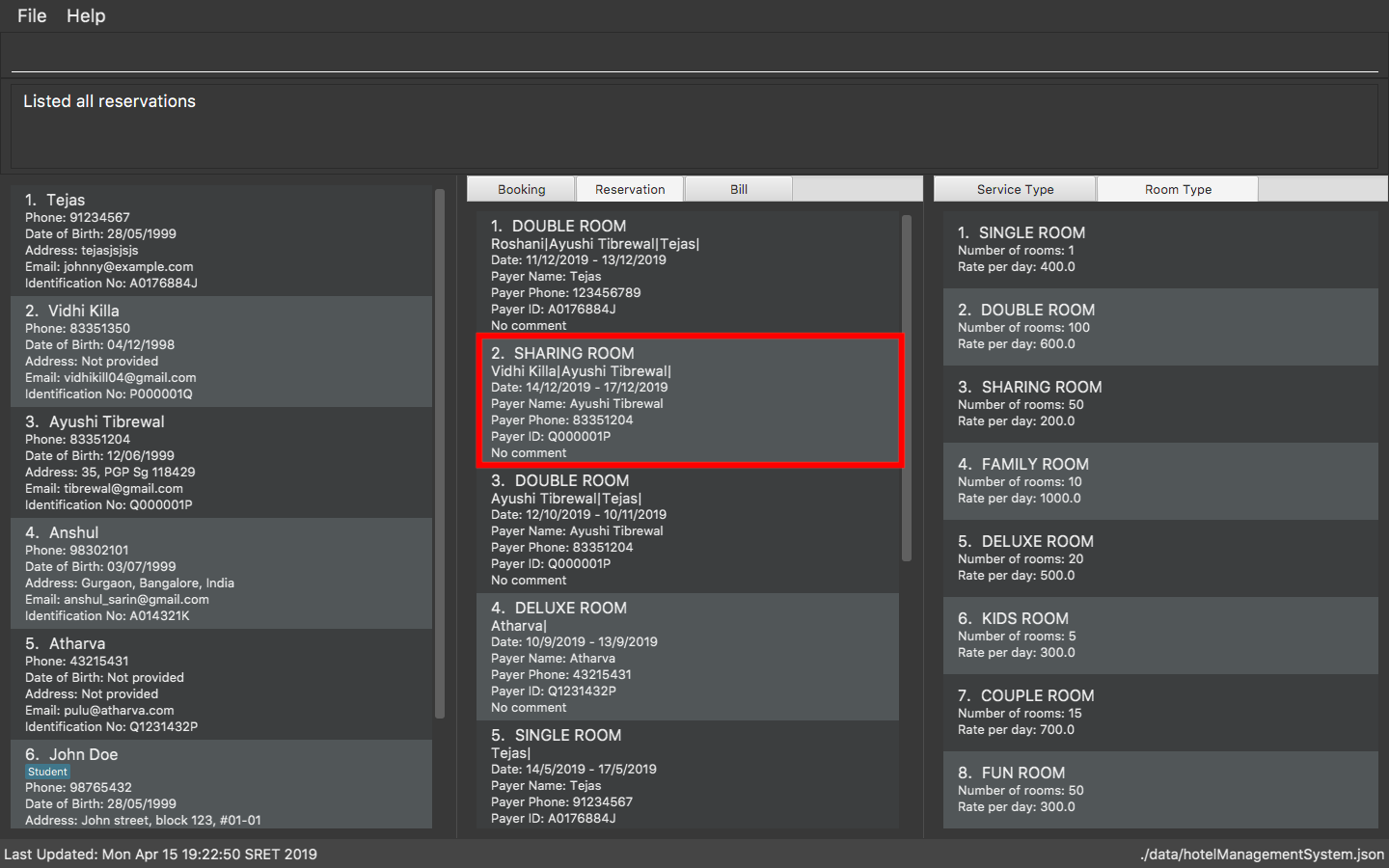
dr 2 command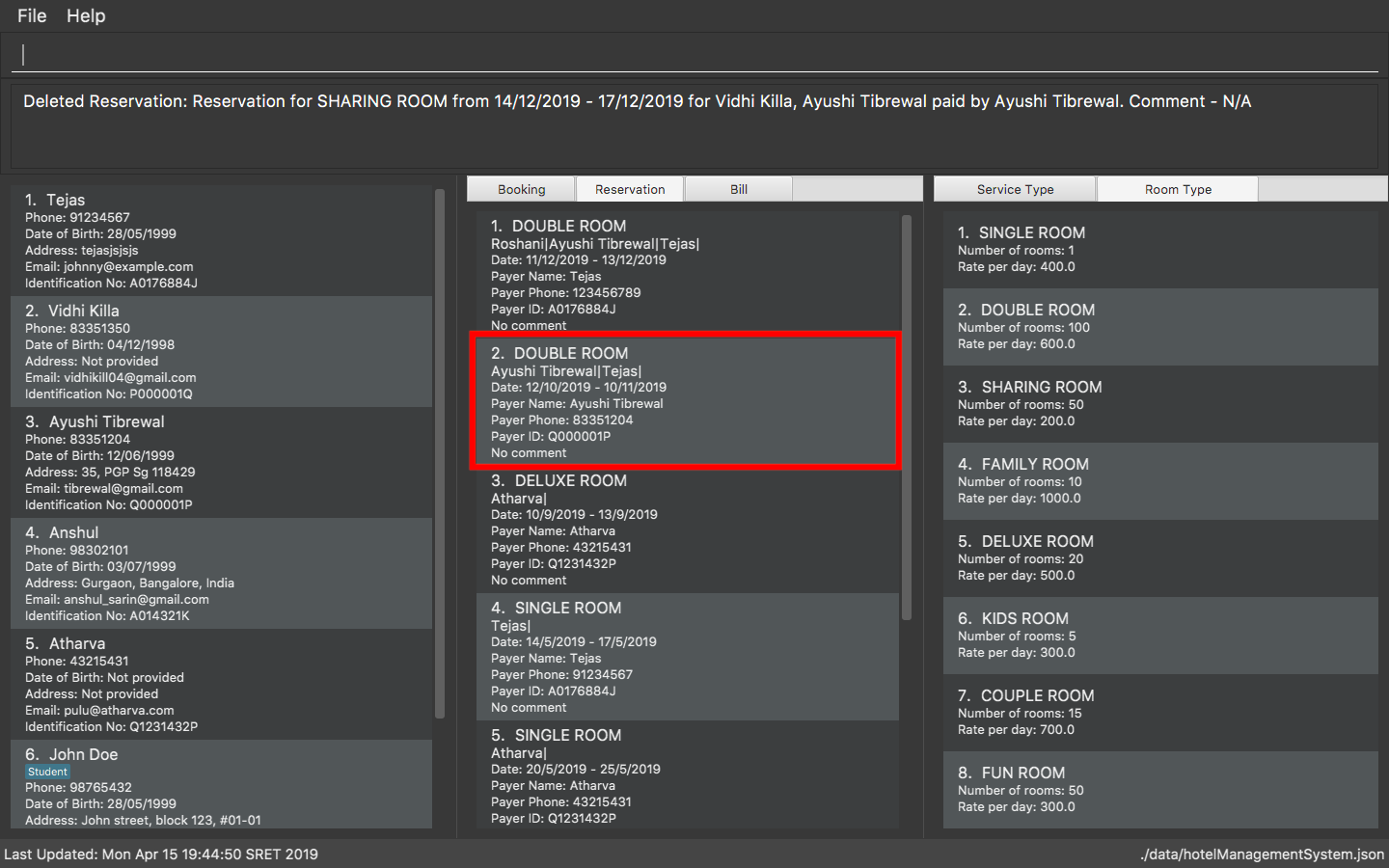
dr 2 command3.4.5. Clearing all reservations: clear-reservations, cr
Effect: Removes all room reservations from the database.
Format: {clear-reservations/cr}
Examples:
-
cr
Clears all reservations from the database.

cr command
cr command3.4.6. Find a reservation: find-reservation, fr
Effect: Displays a reservation list based on the filters given by the user.
Format: {find-reservation/fr} [ id/ IDENTIFICATION_NO ] [ r/ ROOM_TYPE ] [ d/ START_DATE - END_DATE ]
|
|
Example:
-
fr id/Q000001P
Returns all reservations for customer with identification number, Q000001P.

fr id/Q000001P command-
fr id/Q000001P r/SHARING ROOM
Returns all sharing room reservations for customer with identification number, Q000001P.
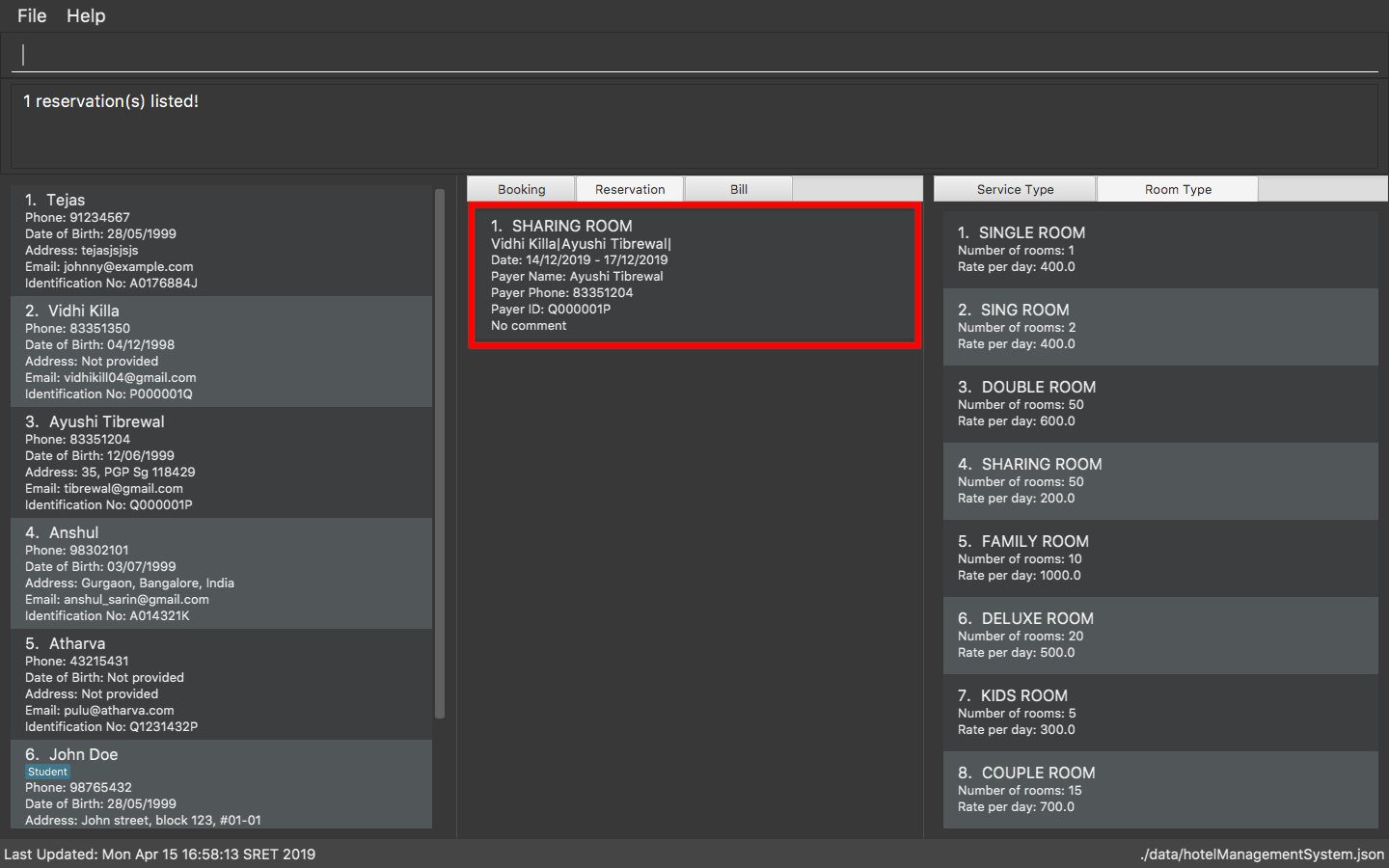
fr id/Q000001P r/SHARING ROOM command3.5. Service Type commands
3.5.1. Adding a service type : add-service-type, ast
Effect: Adds a service type to hotel database. This makes it available for people to do bookings with the added service type.
Format: {add-service-type/ast} n/ SERVICE_NAME cap/ CAPACITY_OF_SERVICE rate/ RATE :/ OPERATIONAL_HOURS
|
|
Example:
-
`art n/SPA cap/50 rate/10.0 :/10-22 `
Adds a service type with name SPA, with a rate of 10.0 and capacity of service equal to 50 and operates from 10am to 10pm
3.5.2. Deleting a service type : delete-service-type, dst
Effect: Deletes a service type from the hotel database. This makes it unavailable for people to do bookings with the deleted service type.
Format: `{delete-service-type/dst} INDEX
|
Example:
-
dst 2
Deletes the service type at index 2.
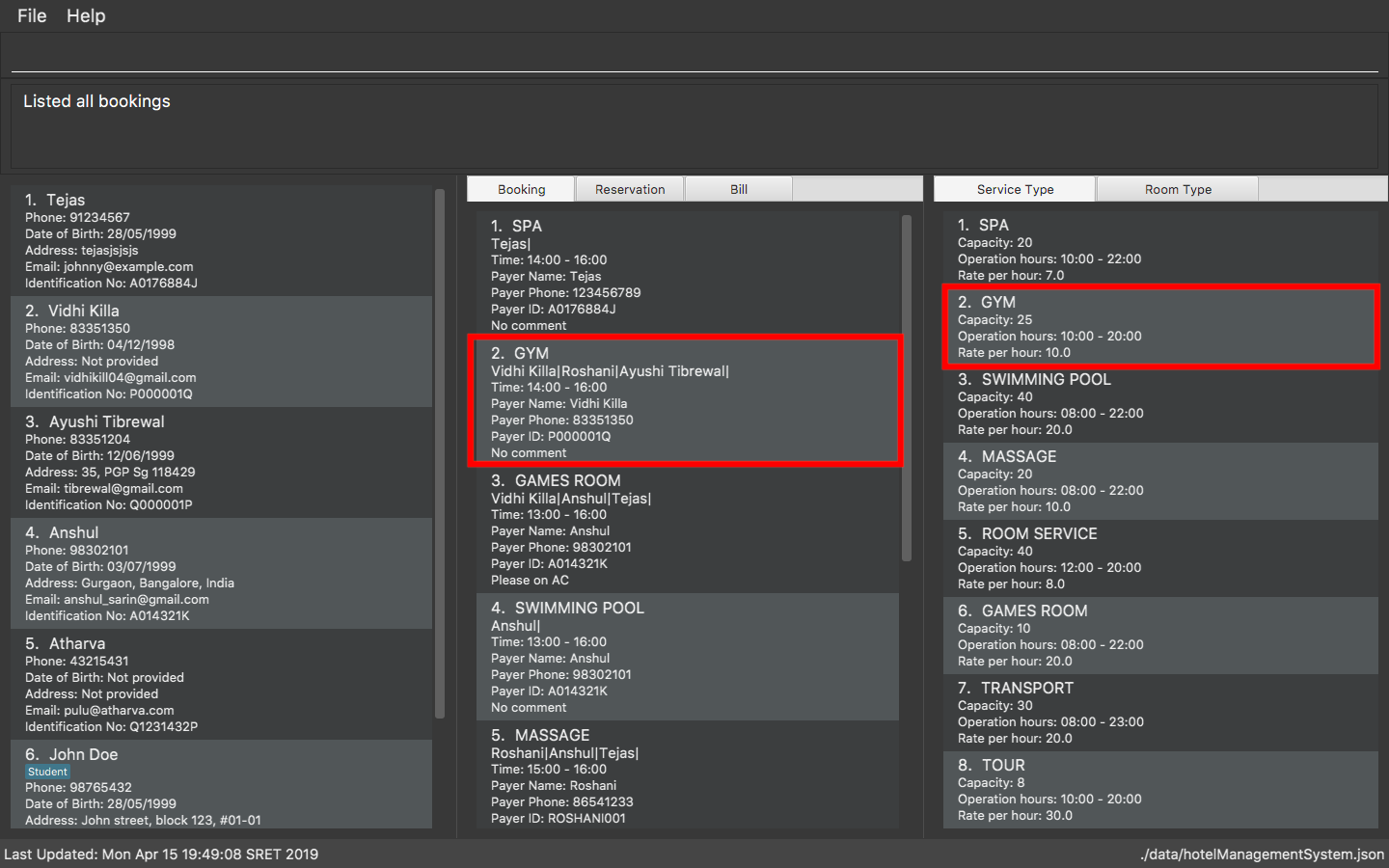
dst 2 command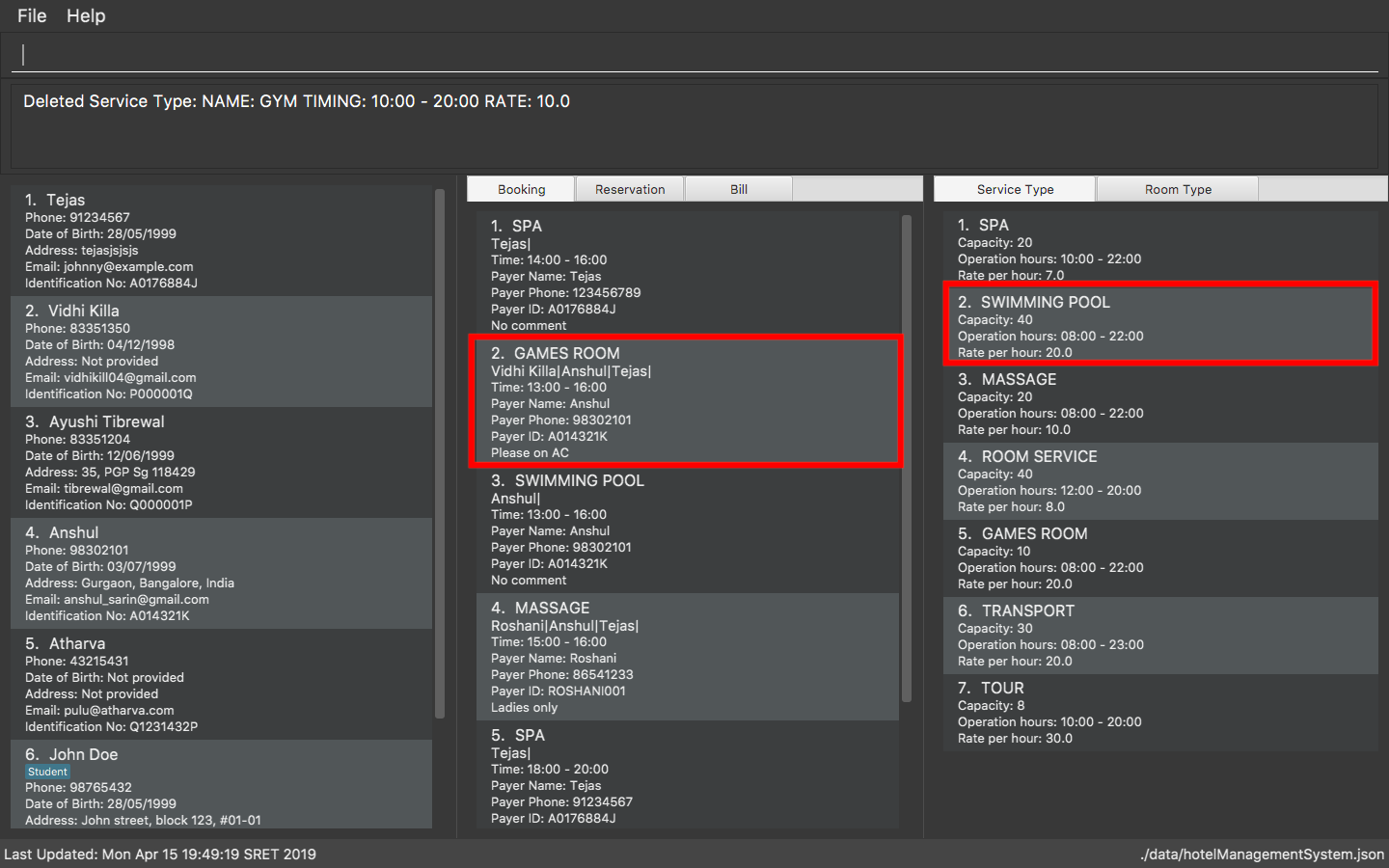
dst 2 command3.5.3. Clearing all service types: clear-service-type, cst
Effect: Removes all service types and service bookings from the database.
Format: {clear-service-type/cst}
Examples:
-
cst
Clears all service types and service bookings from the database.
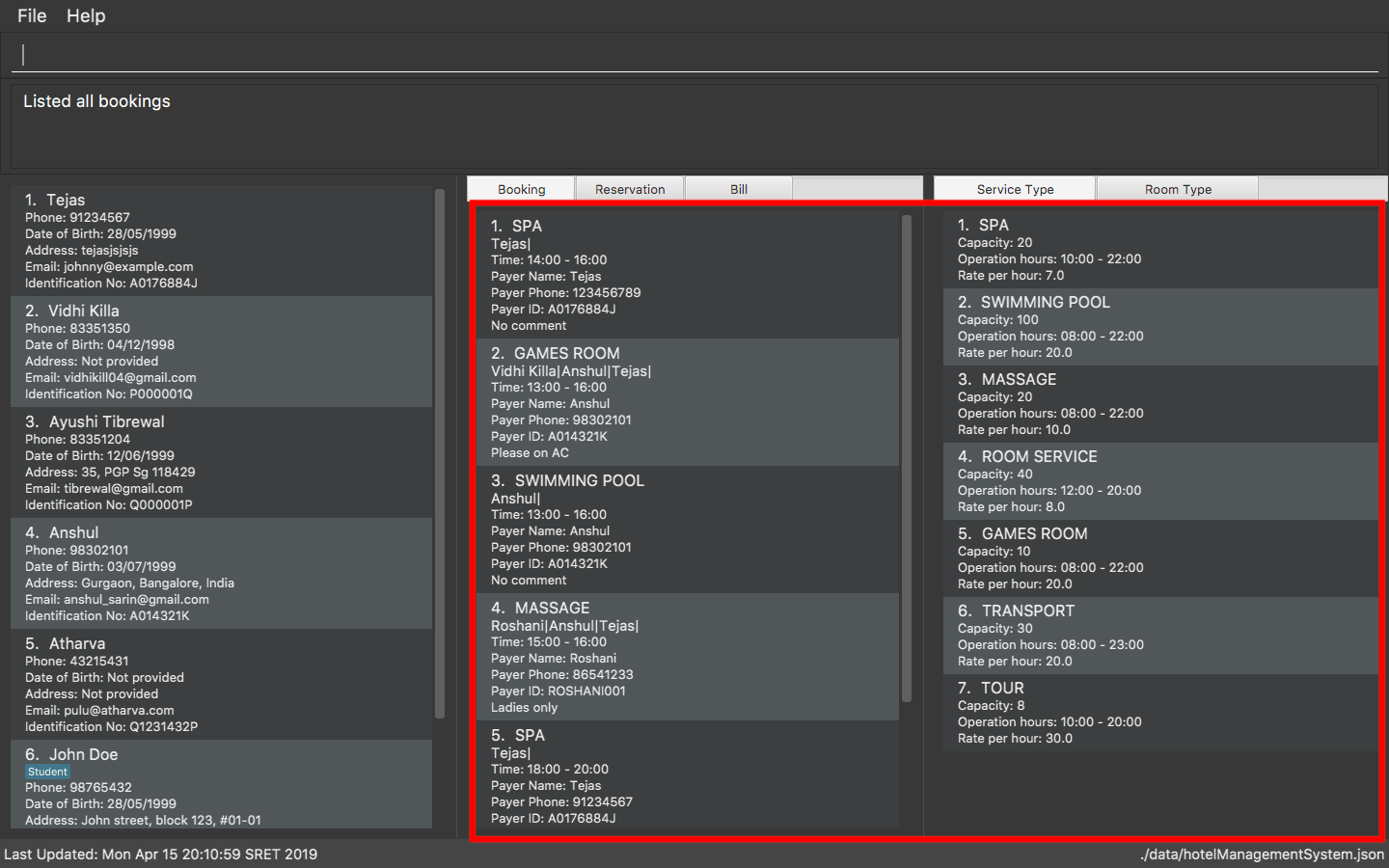
cst command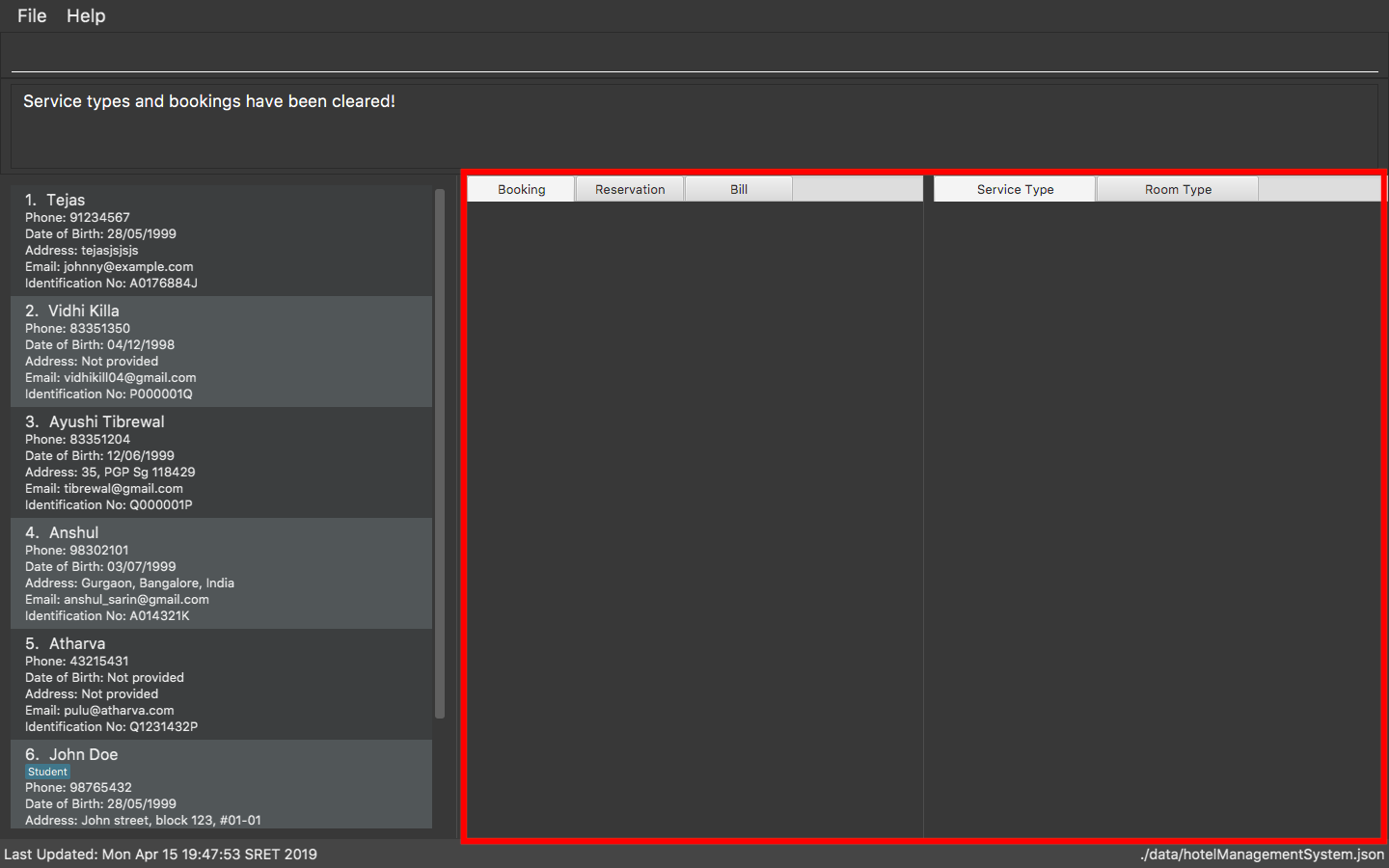
cst command3.5.4. Editing a service type : edit-service-type, est
Effect: Edits the service type at the specified index. This modifies the service available to people to do bookings.
Format: {edit-service-type/est} INDEX [ n/ SERVICE_NAME ] [ cap/ CAPACITY_OF_SERVICE ] [ rate/ RATE ] [ :/ OPERATIONAL_HOURS ]
Example:
-
est 2 cap/100
Edits the service type at index 2 by changing the capacity of the service to 100.

est 2 command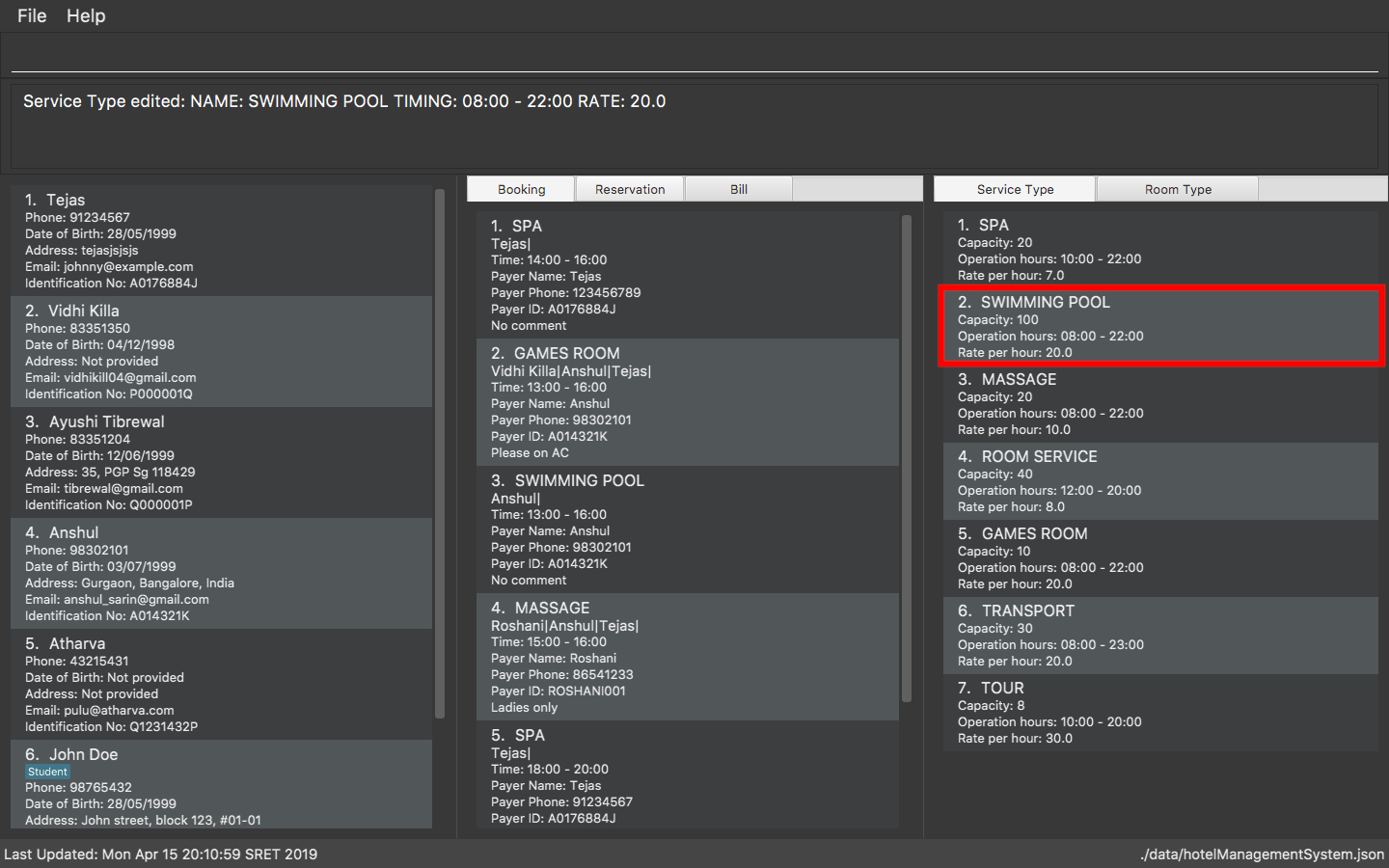
est 2 command3.6. Service Booking commands
3.6.1. Booking a service: add-booking,ab
Effect: Adds a service associated with certain customers.
Format: {add-booking/ab} s/ SERVICE_NAME :/ START_TIME-END_TIME $/ PAYER_INDEX [ c/ MORE_CUSTOMER_INDICES ] [ com/ COMMENTS ]
|
Examples:
-
lc, thenadd-booking s/SWIMMING POOL :/12-14 $/2Adds a booking for service SWIMMING POOL, for the 2nd customer from the complete customer list, from 12:00 to 14:00 if the service is available.

above command3.6.2. Listing all booked services: list-bookings,lb
Effect: Displays a booking list, which lists all the bookings made till now.
Format: {list-bookings/lb}
Example:
-
lb
Lists all bookings.

lb command3.6.3. Editing a booked service: edit-booking, eb
Effect: Edits the fields of a booking in the database.
Format: {edit-booking/eb} INDEX [ s/ SERVICE_NAME ] [ :/ START_TIME-END_TIME ] [ p/ PAYER_INDEX ] [ c/ MORE_CUSTOMER_INDICES ] [ com/ COMMENTS ]
|
You can remove all the booking’s comments by typing com/ without specifying any tags after it.
|
Examples:
-
lb, theneb 1 s/TRANSPORTEdits the service type of the 1st booking to be GYM.
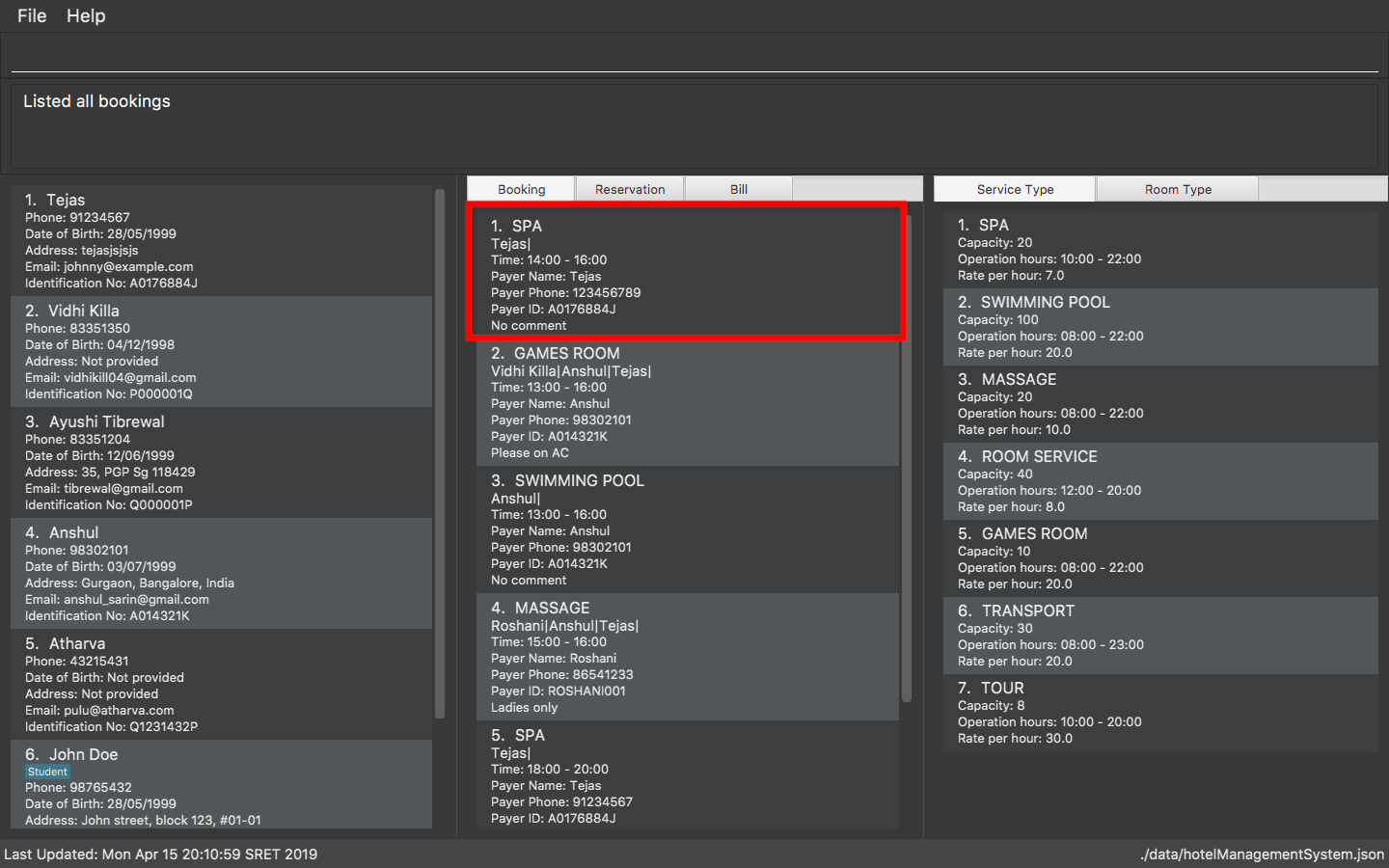
eb 1 s/TRANSPORT command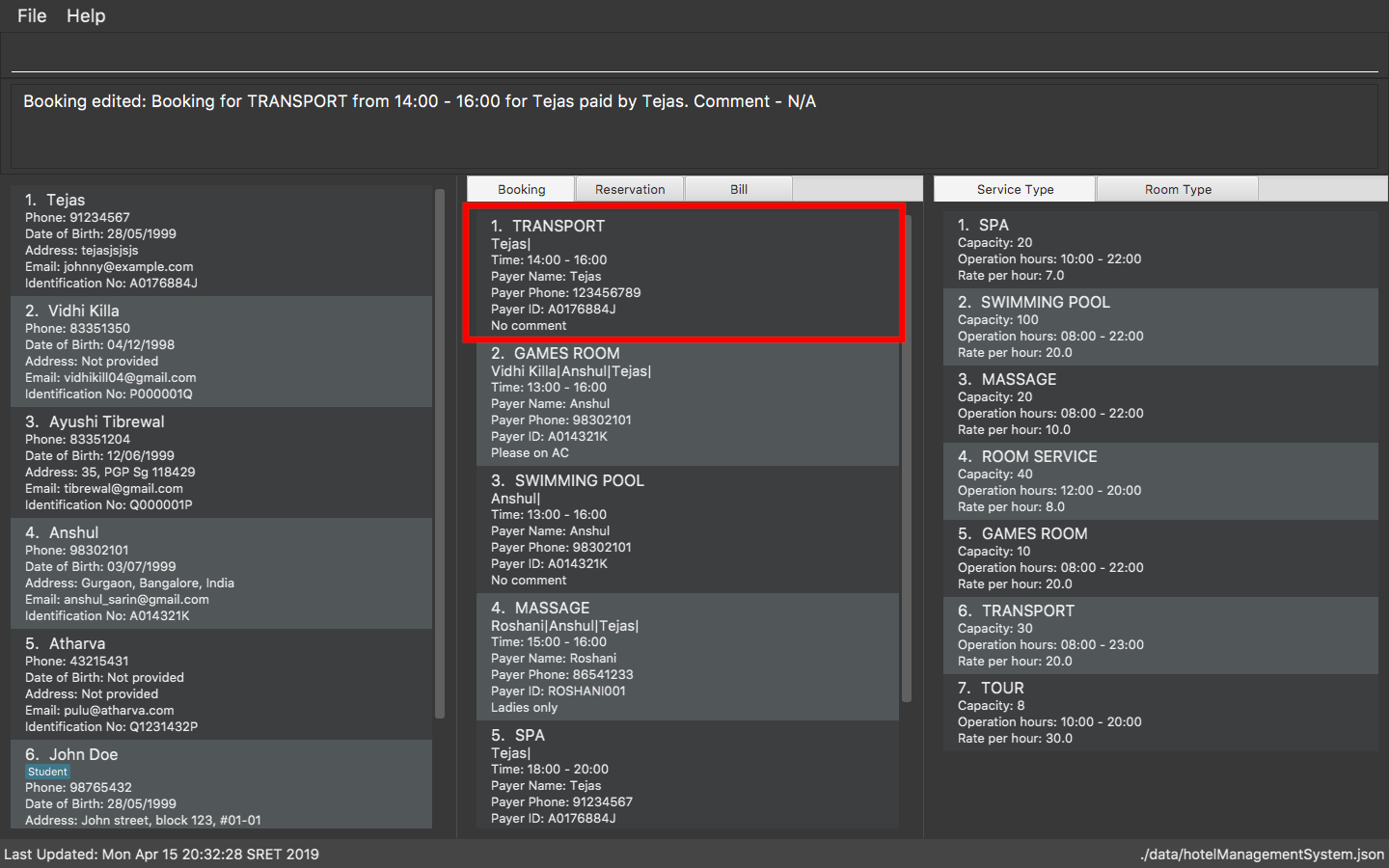
eb 1 s/TRANSPORT command-
lb, thenedit-booking 2 :/14-15 com/Edits the timing of the 2nd booking to be 14:00 - 15:00 and clears all existing comments.
3.6.4. Deleting a booked service: delete-booking, db
Effect: Deletes a booking from the database.
Format: {delete-booking/db} INDEX
|
Example:
lb, then delete-booking 2
Deletes the 2nd booking of the booking database

delete-booking 2 command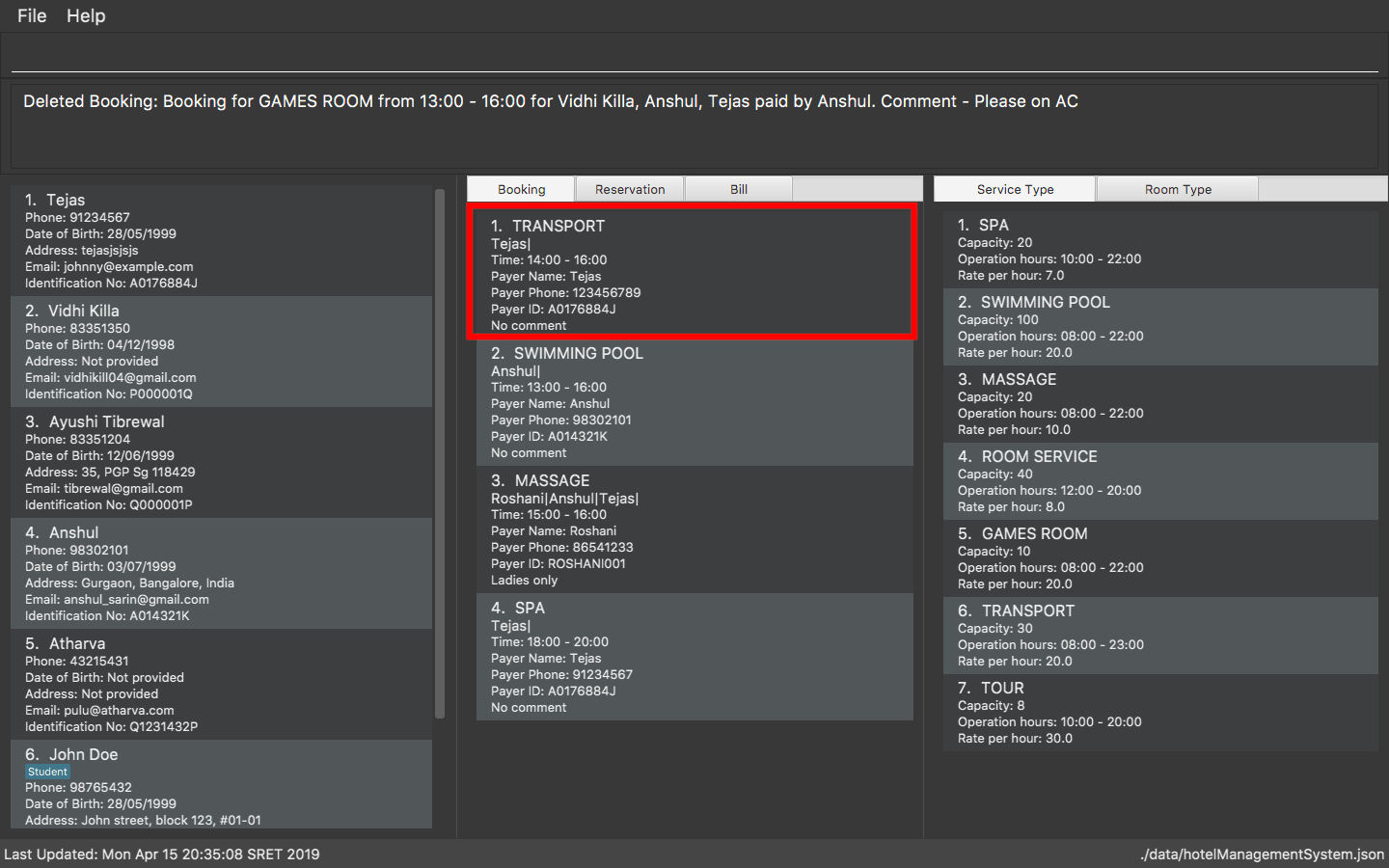
delete-booking 2 command3.6.5. Clearing all bookings: clear-bookings, cb
Effect: Removes all service bookings from the database.
Format: {clear-bookings/cb}
Example:
-
cb
Clears all bookings from the database.

cb command
cb command3.6.6. Find a specific booking: find-booking, fb
Effect: Displays a booking list based on the filters given by the user.
Format: {find-booking/fb} [ id/ IDENTIFICATION_NO ] [ s/ SERVICE_NAME ] [ :/ START_TIME-END_TIME ]
|
Example:
-
fb id/A0176884J
Returns all bookings for customer with identification number, A0176884J.

fb id/A0176884J command-
fb id/A0176884J s/SPA
Returns all spa bookings for customer with identification number, A0176884j.
3.7. Generate Bill commands
|
All generate bill commands only display the bill. They don’t make any change in the storage or the database. That is, the bill isn’t stored anywhere. So any changes in the database due to other commands while bill is being displayed doesn’t affect it. To see the new update in the bill, the command needs to be inputted again. |
3.7.1. Generate bill for specific booking: generate-bill-booking, gb-b
Effect: Generates the bill for the specific booking of a customer
Format: {generate-bill-booking/gb-b} INDEX [ s/ SERVICE_NAME ] [ :/ START_TIME - END_TIME ]
Example:
-
lc, thengenerate-bill-booking 4
Returns the bill for all services booked by the customer at index 4.
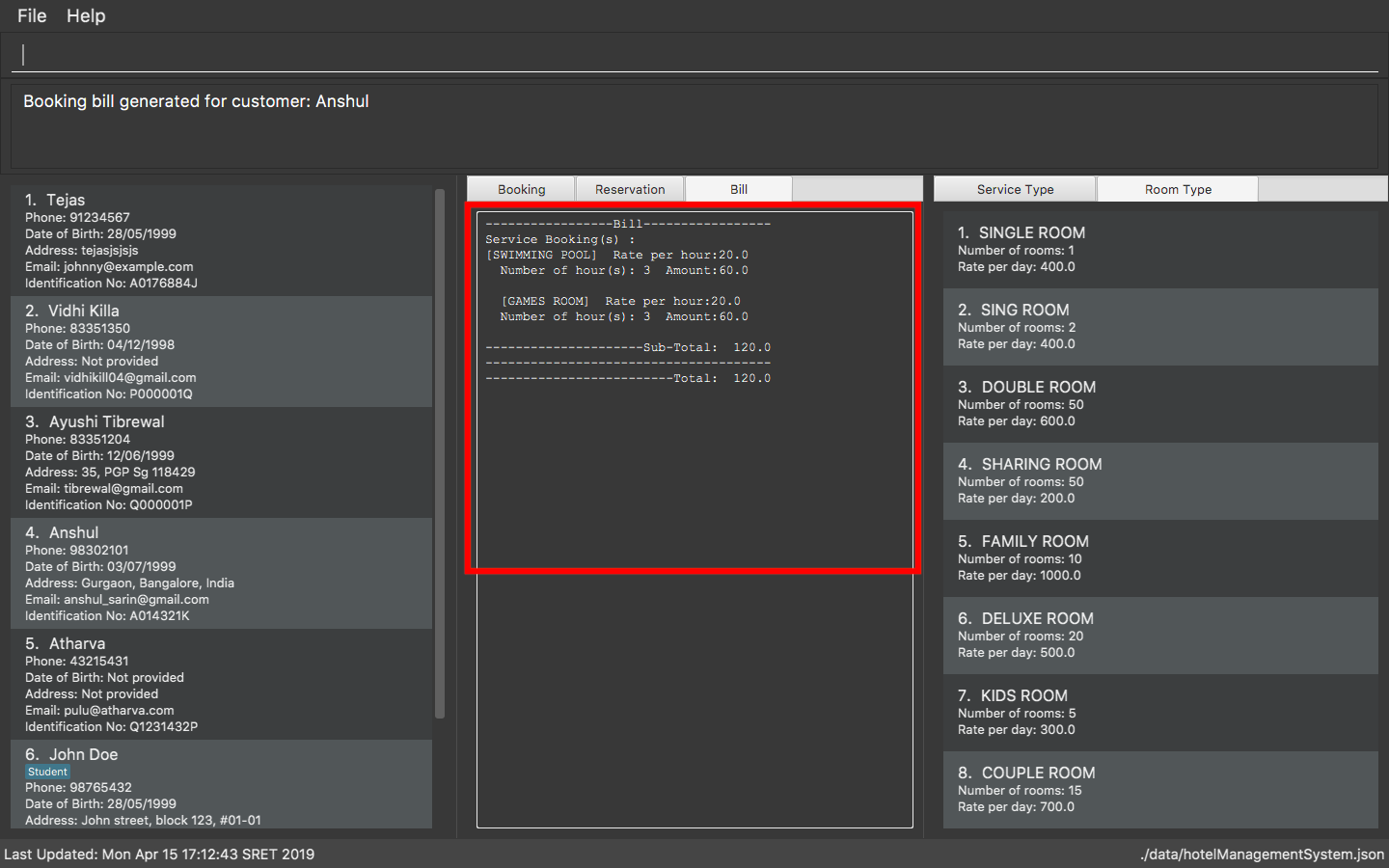
generate-bill-booking 4 command-
lc, thengb-b 1 s/SPA
Returns the bill for all spa services booked for the customer at index 1.

gb-b 1 s/SPA command3.7.2. Generate bill for specific reservation: generate-bill-reservation, gb-r
Effect: Generates the bill for the specific booking of a customer
Format: {generate-bill-reservation/gb-r} INDEX [ r/ ROOM_TYPE ] [ d/ START_DATE - END_DATE ]
|
Example:
-
lc, thengenerate-bill-reservation 1
Returns the bill for all rooms reserved by the customer at index 1.

generate-bill-reservation 1 command-
lc, thengb-r 3 r/SHARING ROOM
Returns the bill for all sharing rooms reserved by the customer at index 3.

gb-r 3 r/SHARING ROOM command3.7.3. Generate customer’s bill : generate-bill-customer, gb-c
Effect: Generates the bill for the customer based on his total room reservations and service bookings.
Format: {generate-bill-customer/gb-c} INDEX
|
This command is a super set of all the other "generate bill" commands and can be used to obtain the complete breakup for a customer. |
Example:
-
lc, then `generate-bill-customer 1
Returns the total bill (includes all bookings and reservations) for the customer at index 1.
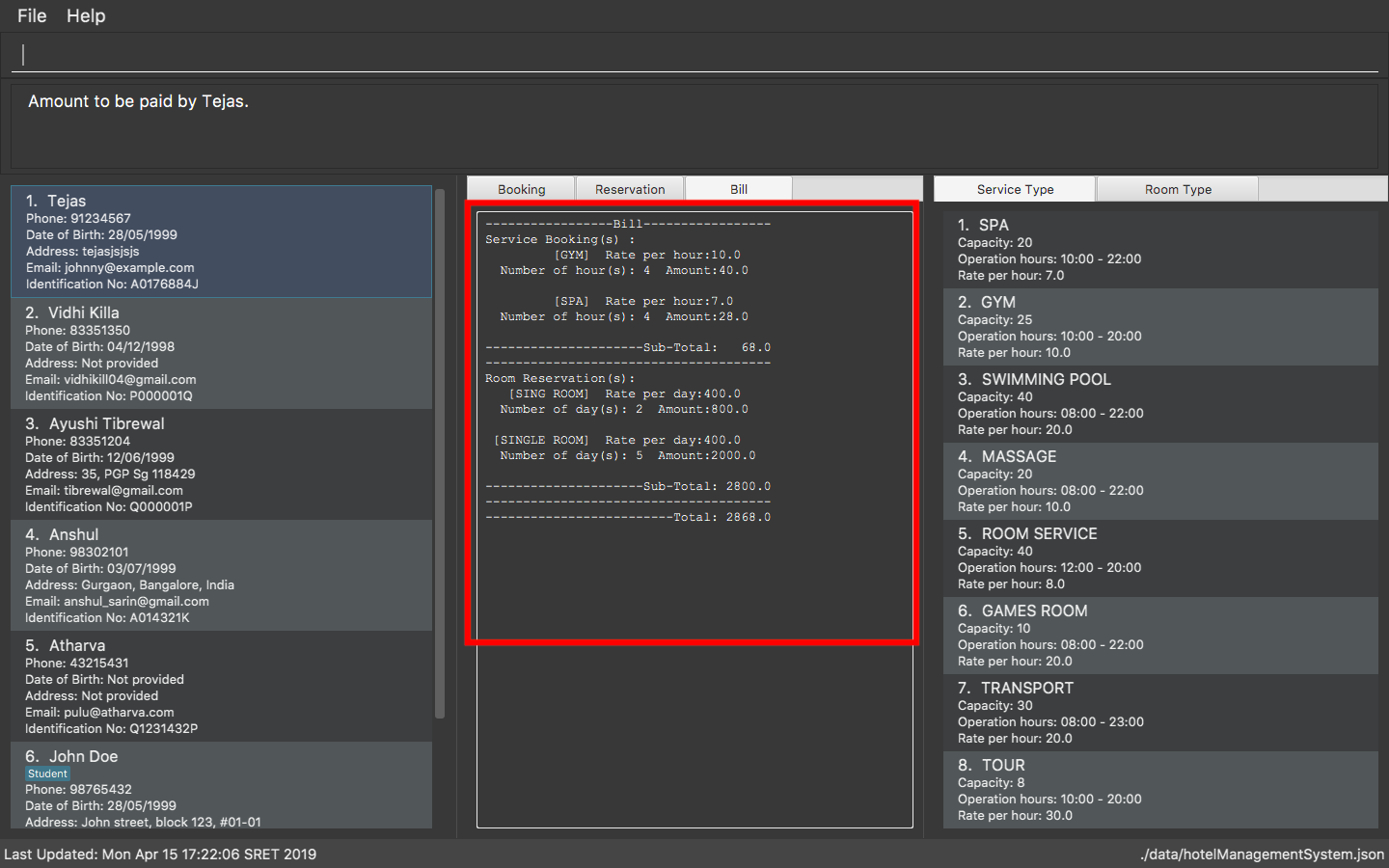
generate-bill-customer 1 command3.8. Show Statistics command : show-stats, ss
Effect: Displays an individual window for statistics, including a text report and the charts.
Format: {show-stats/ss} [ INDICES_OF_ITEMS… ]
|
Example:
-
ss
This displays all stats items available.

ss command-
ss 1 3
This displays the 1st and the 3rd stats items.
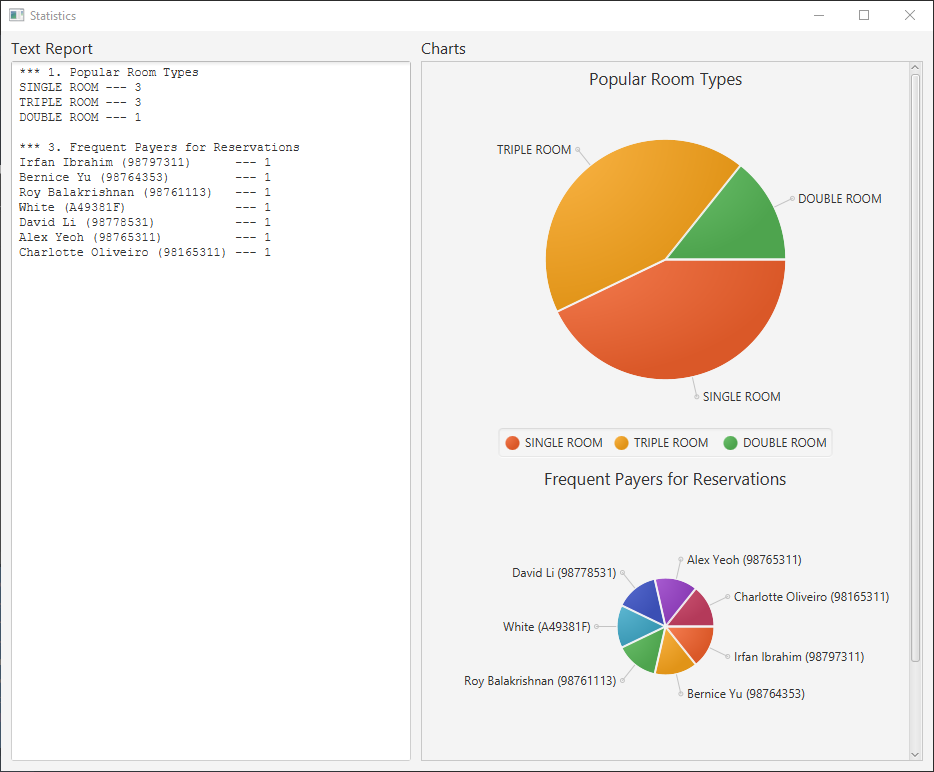
ss 1 3 command3.9. Switch tab command : switch-tab, st
Effect: Switches the panel and the tab based on input by the user.
Format: {switch-tab/st} PANEL_NUMBER TAB_NUMBER
|
Panel Number 1: Consists of |
Example:
-
st 1 1
This will switch to the booking tab in the the first panel.
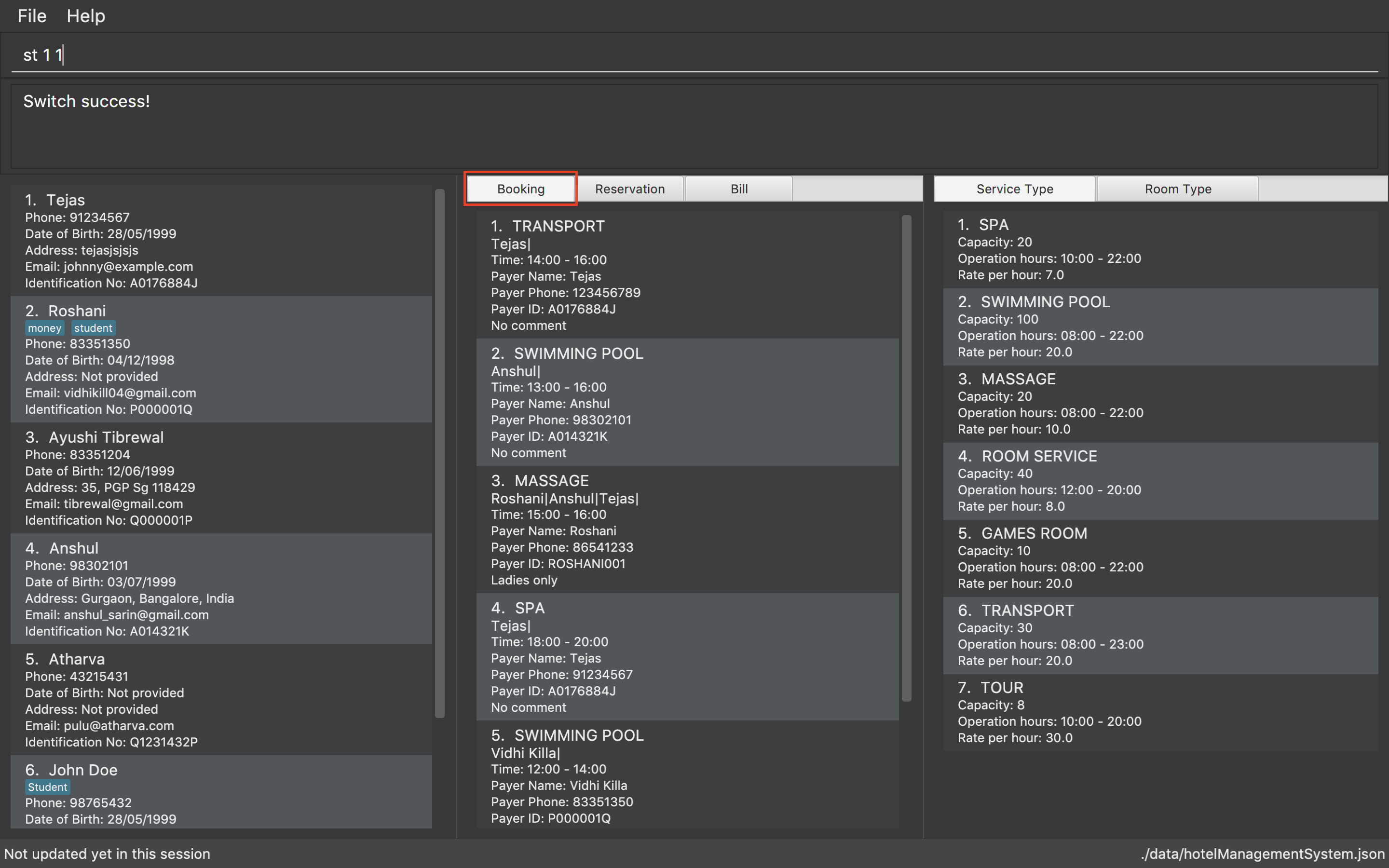
st 1 1 command-
st 2 1
This will switch to the service type tab in the second panel.
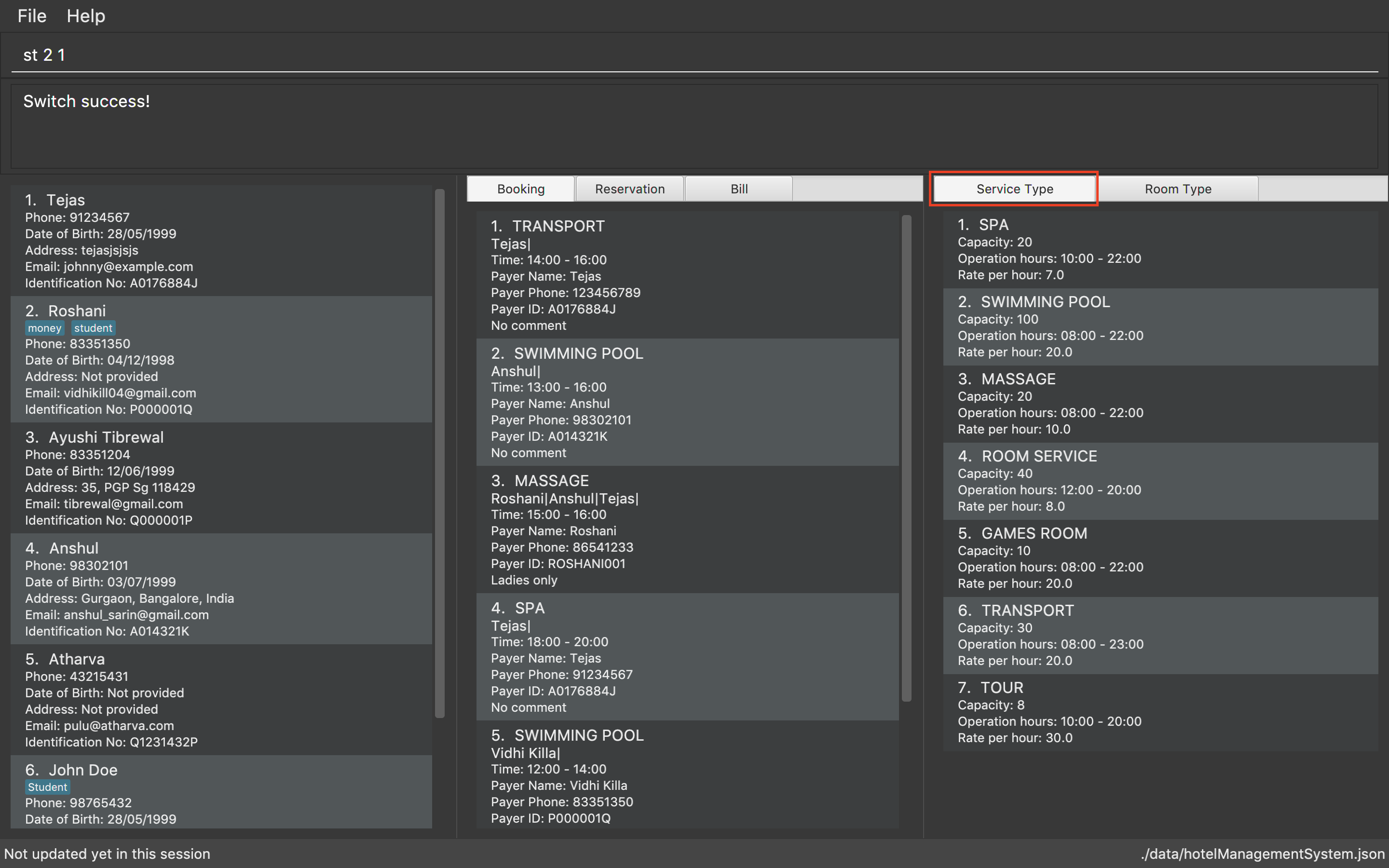
st 2 1 command3.10. Select customer command : select, s
Effect: Selects the customer whose index is specified.
Format: {select/s} INDEX
Example:
-
s 1
Selects the customer at index 1.

s 11 command3.11. Listing entered commands : history,hs
Effect: Lists all the commands that you have entered in reverse chronological order.
Format: {history/hs}
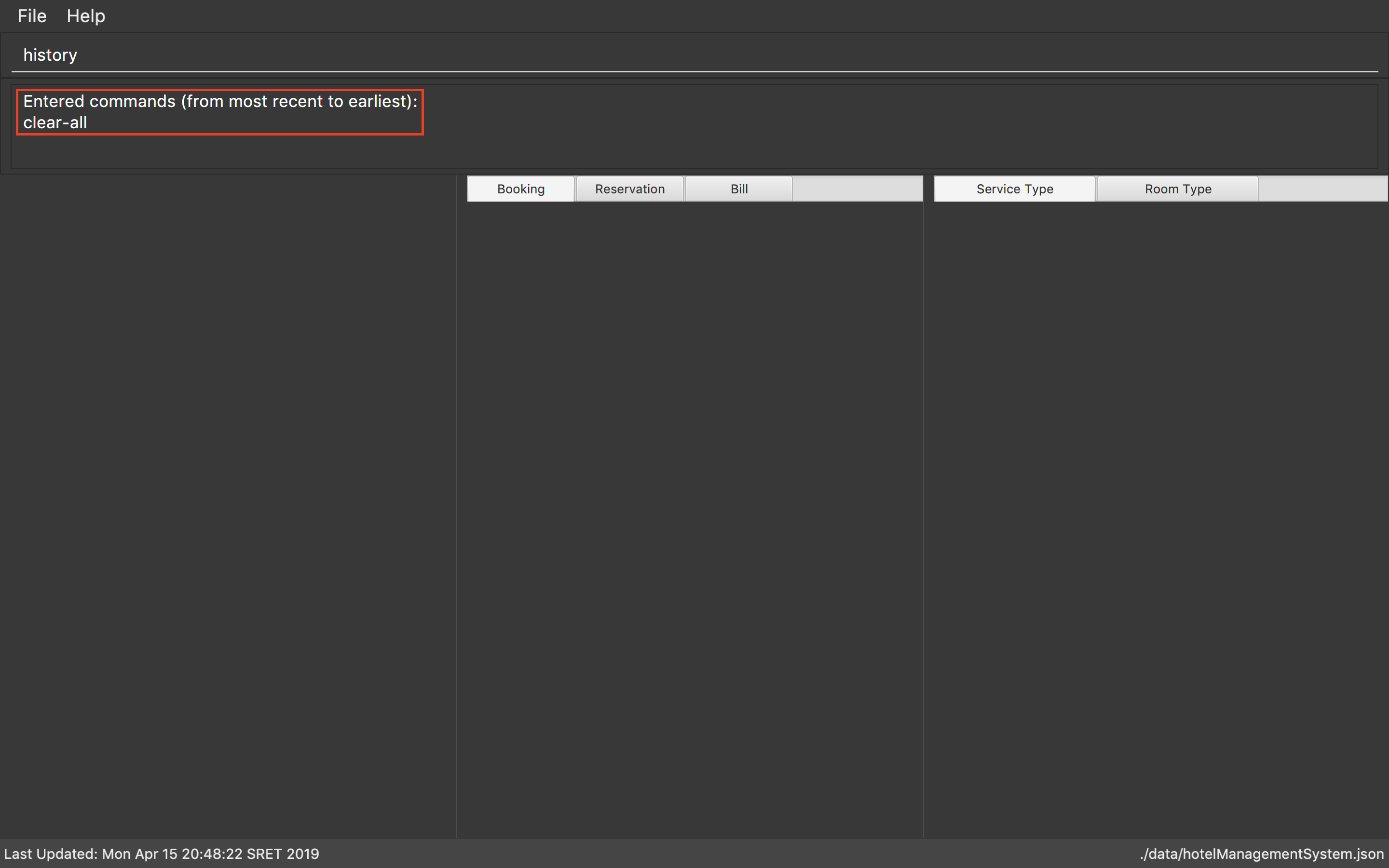
clear-all command|
Pressing the ↑ and ↓ arrows will display the previous and next input respectively in the command box. |
3.12. Undoing previous command : undo,u
Effect: Restores the address book to the state before the previous undoable command was executed.
Format: {undo/u}
|
Undoable commands: those commands that modify HMS’s content ( |
Examples:
-
delete-customer 1
lc
undo(adds back the deleted customer)

-
lc
undo
Theundocommand fails as there are no undoable commands executed previously. -
delete-customer 1
clear-all
undo(adds back all cleared entries)
undo(adds back the previously deleted customer)
3.13. Redoing the previously undone command : redo,r
Effect: Reverses the most recent undo command.
Format: {redo/r}
Examples:
-
delete-customer 1
undo(adds back the deleted customer)
redo(deletes customer at index 1 again)

undo and redo command-
delete-customer 1
redo
Theredocommand fails as there are noundocommands executed previously. -
delete-customer 1
clear
undo(adds back all cleared entries)
undo(adds back the previously deleted customer)
redo(deletes customer at index 1 again)
redo(clears all remaining entries again)
3.14. Clearing all entries : clear-hms, clear-all
Effect: Clears all entries from the database.
Format: {clear-hms/clear-all}
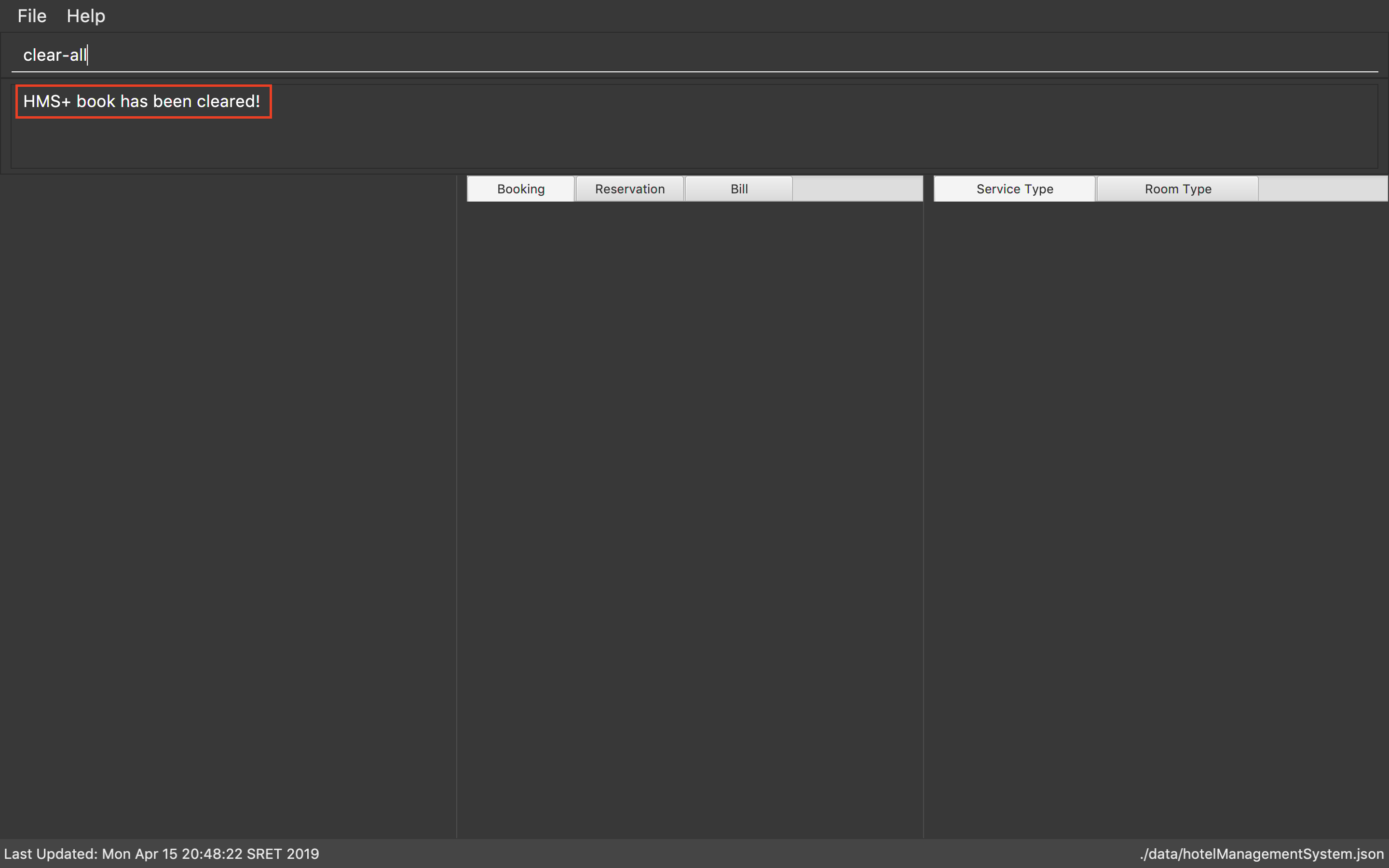
clear-all command3.15. Exiting the program : exit,ex
Effect: Exits the program.
Format: {exit/ex}
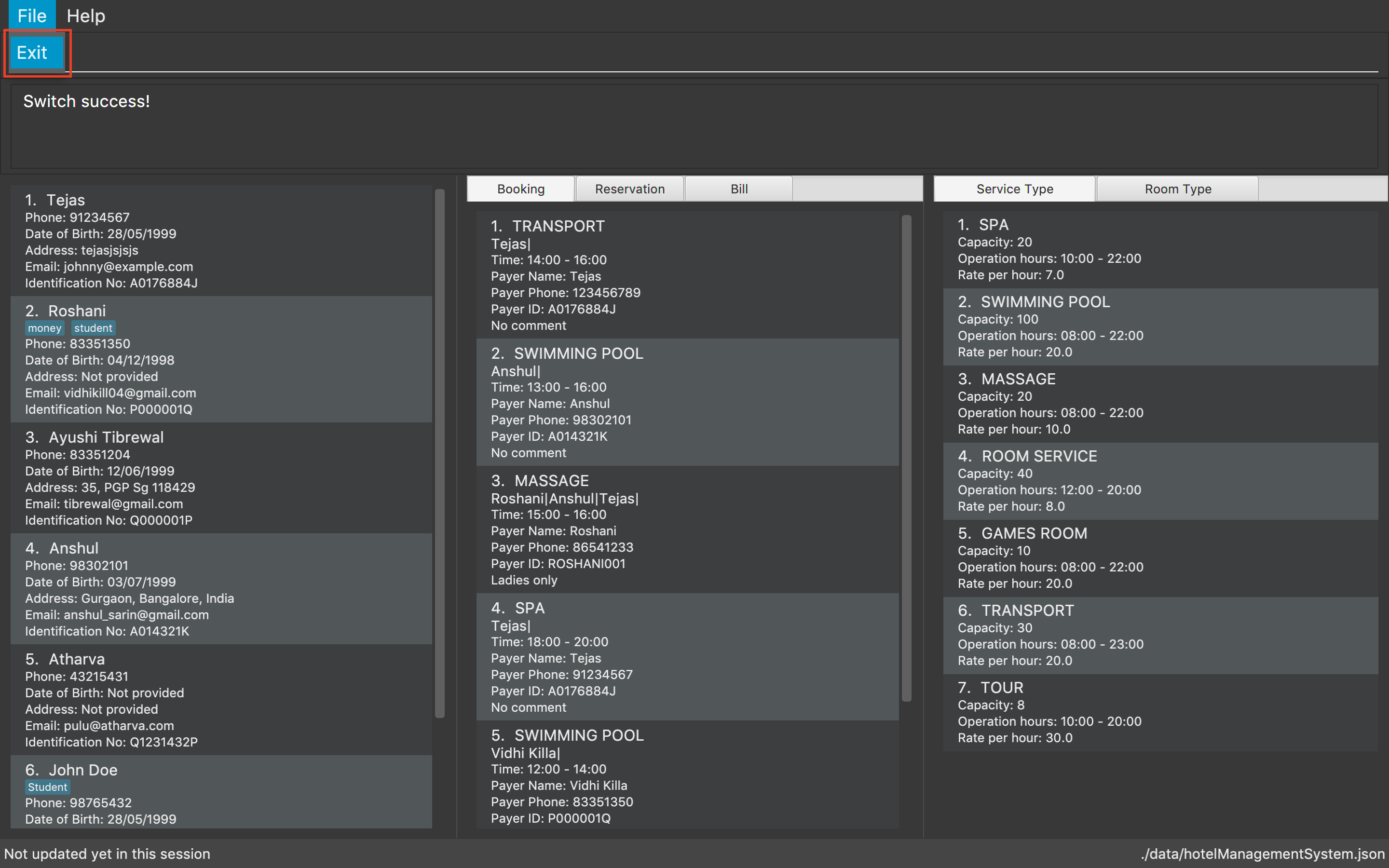
exit command3.16. Automatic tab switching
The tab will be switched automatically to show the content.
3.16.1. Service Booking
All service booking related commands will switch tab to the one for Booking and the one for Service Type.
Example:
-
lb
All bookings will be shown and the tab will also be switched
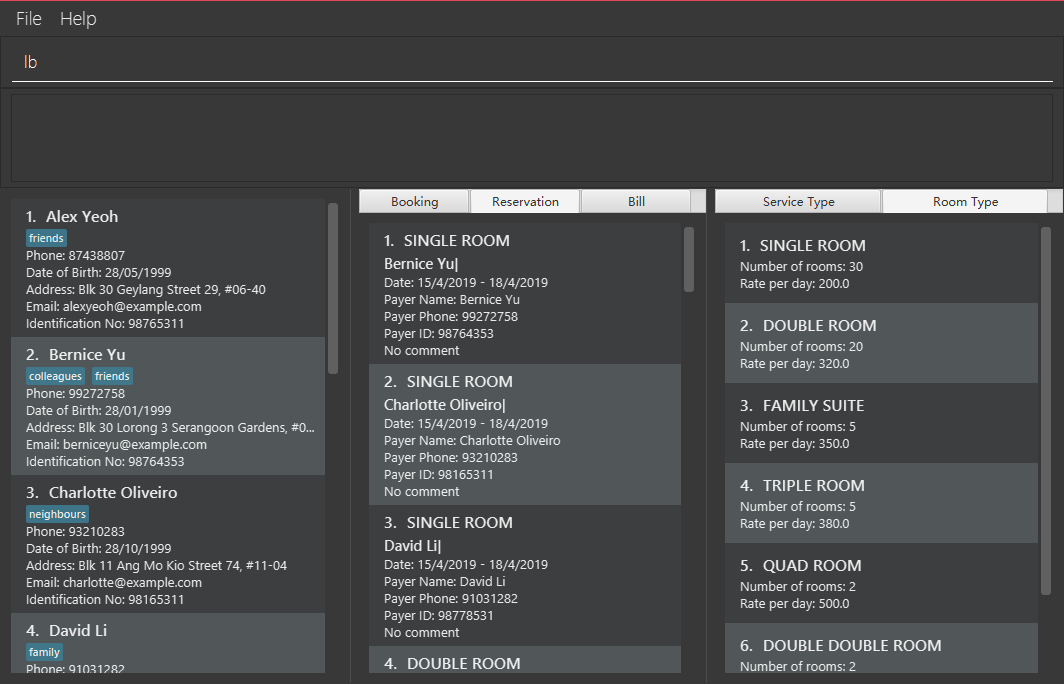
lb command before executing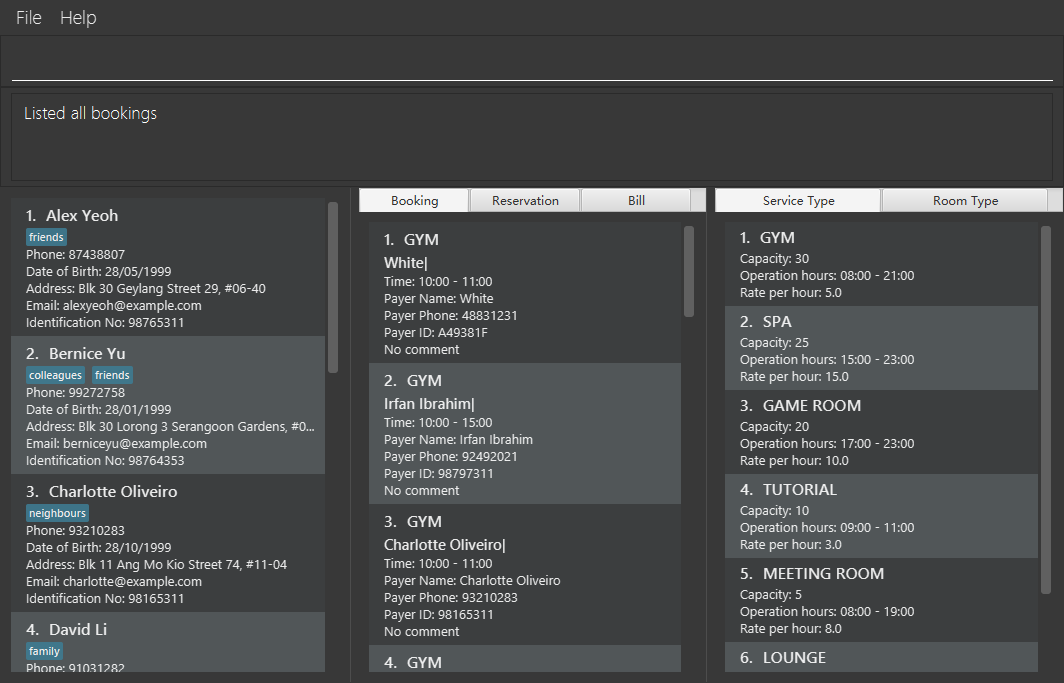
lb command after executing3.16.2. Room Reservation
All room reservation related commands will switch tab to the one for Reservation and the one for Room Type.
Example:
-
lr
All reservations will be shown and the tab will also be switched.
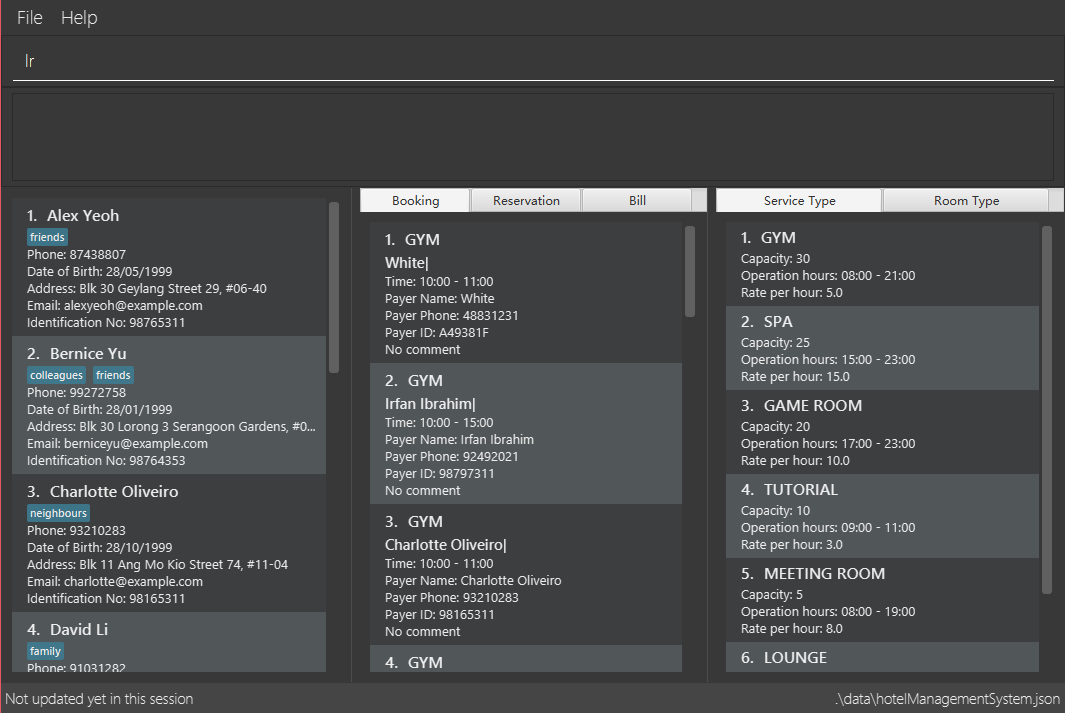
lr command before executing
lr command after executing3.16.3. Bill
All bill related commands will switch tab to the one for Bill.
Example:
-
gb-c 1
The bill be generated and the tab will also be switched.
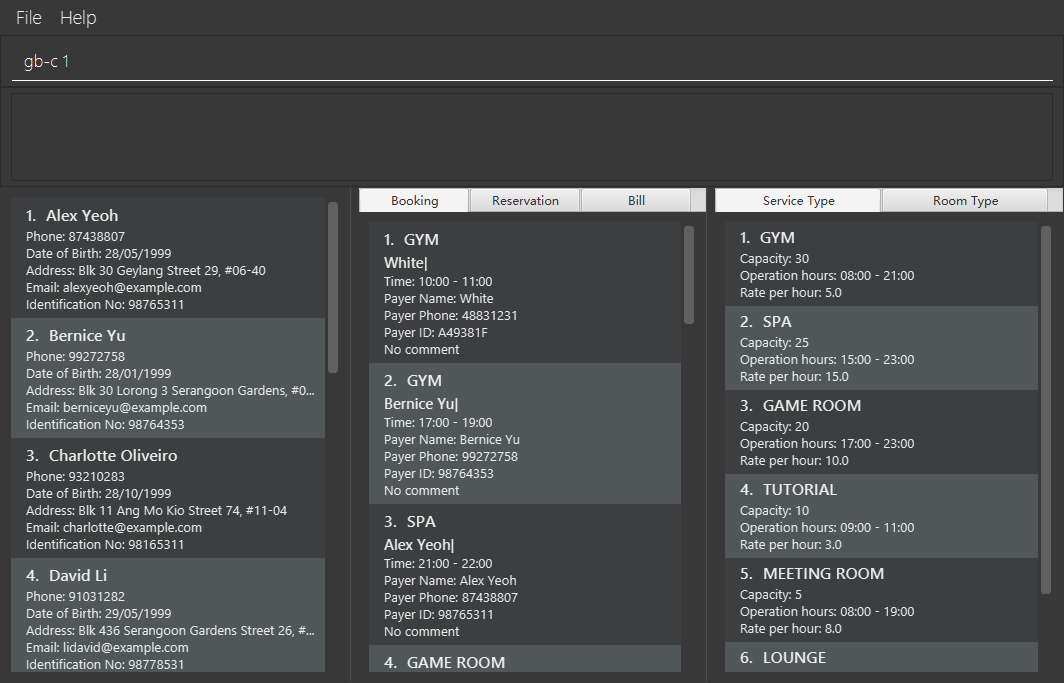
gb-c 1 command before executing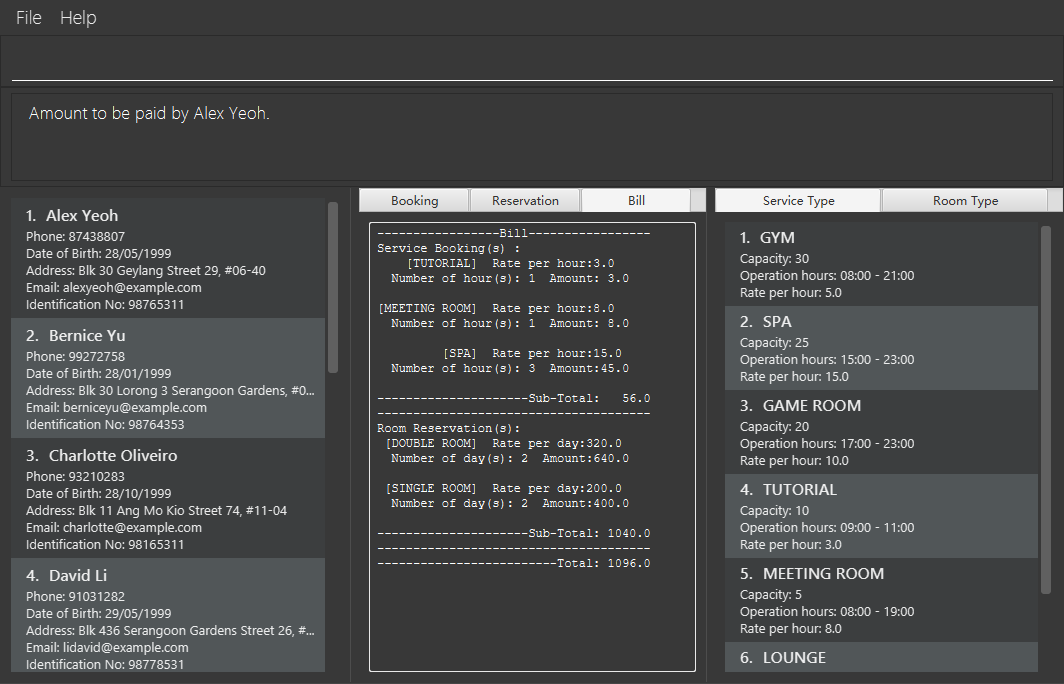
gb-c 1 command after executing3.17. Automatic panel scrolling
3.17.1. Service Booking
The customer panel will be scrolled automatically to show the newly added item.
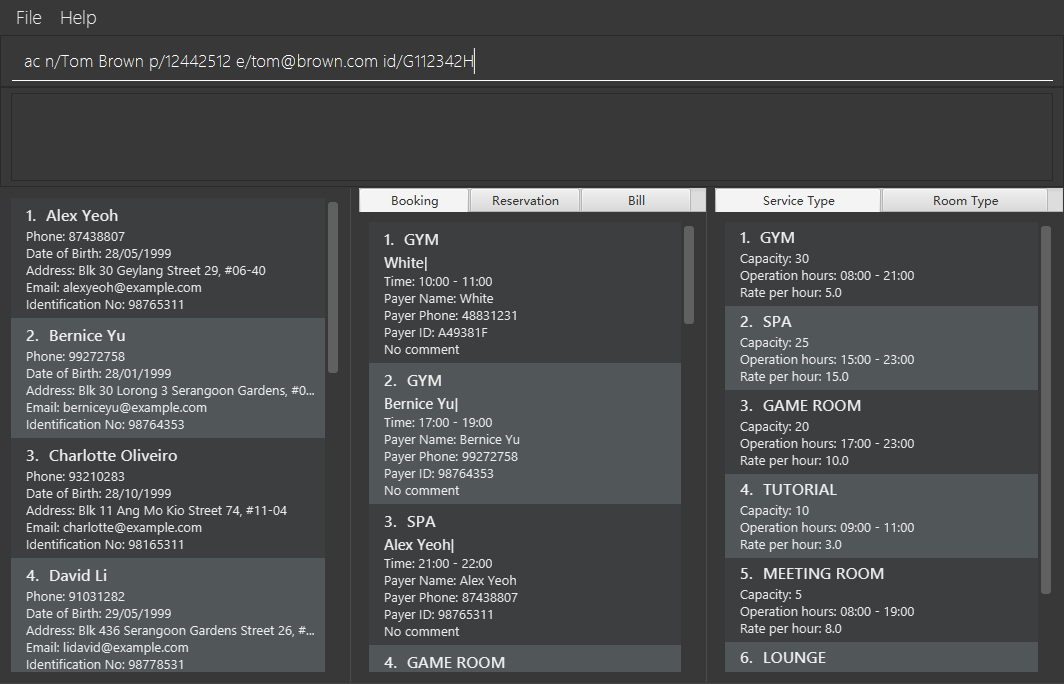
ac n/Tom Brown p/12442512 e/tom@brown.com id/G112342H command before executing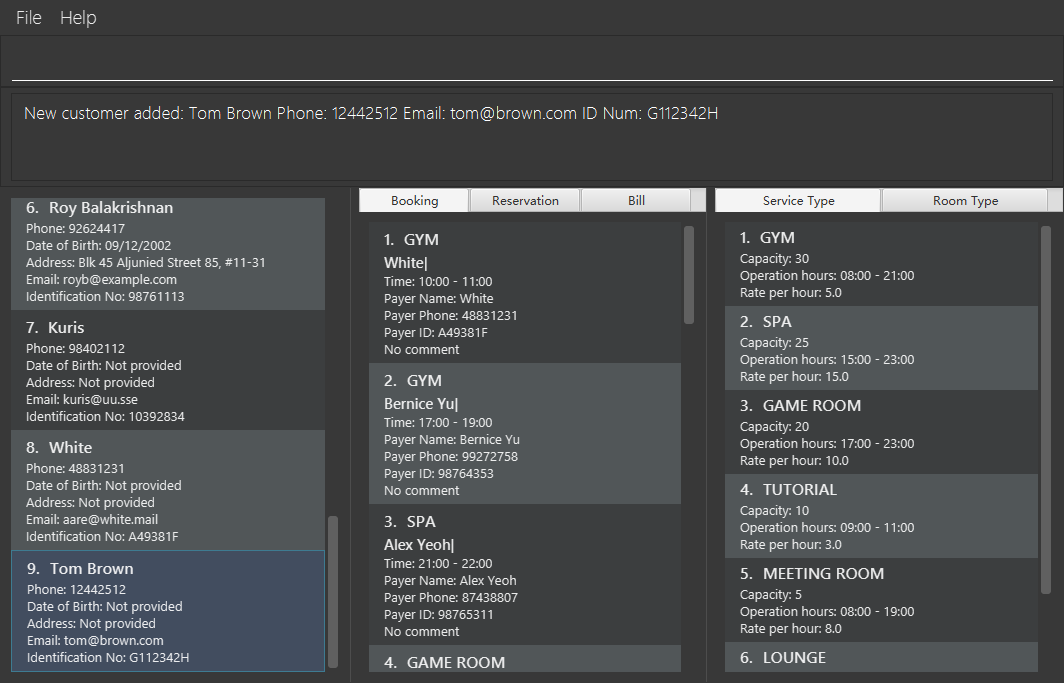
ac n/Tom Brown p/12442512 e/tom@brown.com id/G112342H command after executing3.17.2. Service Booking
The booking panel will be scrolled automatically to show the newly added item.
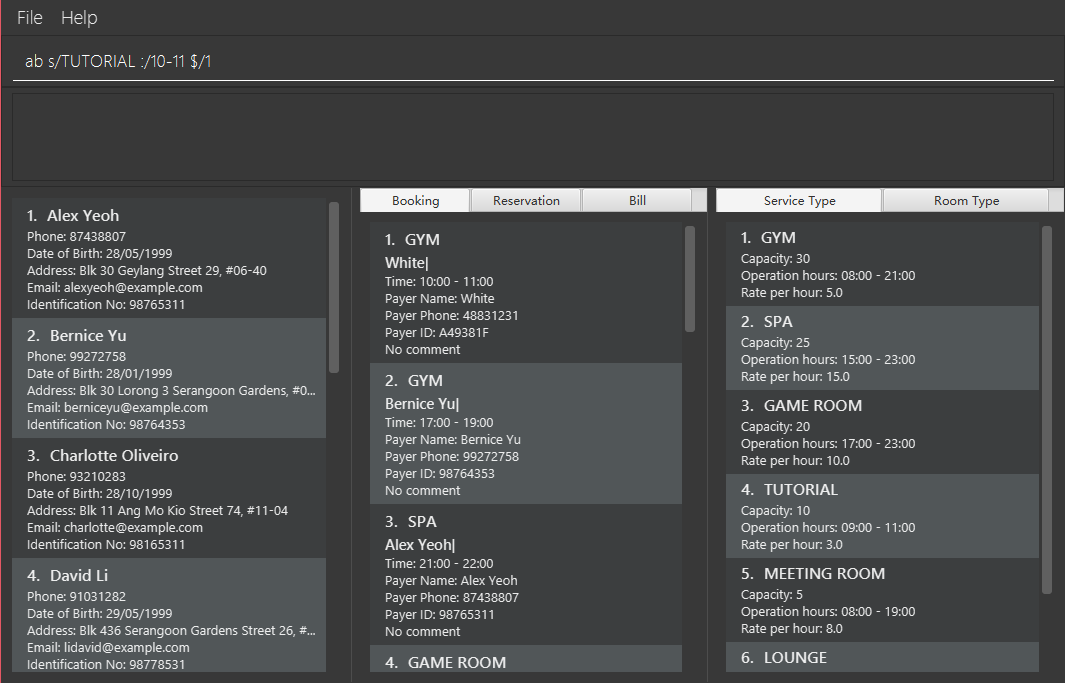
ab s/TUTORIAL :/10-11 $/1 command before executing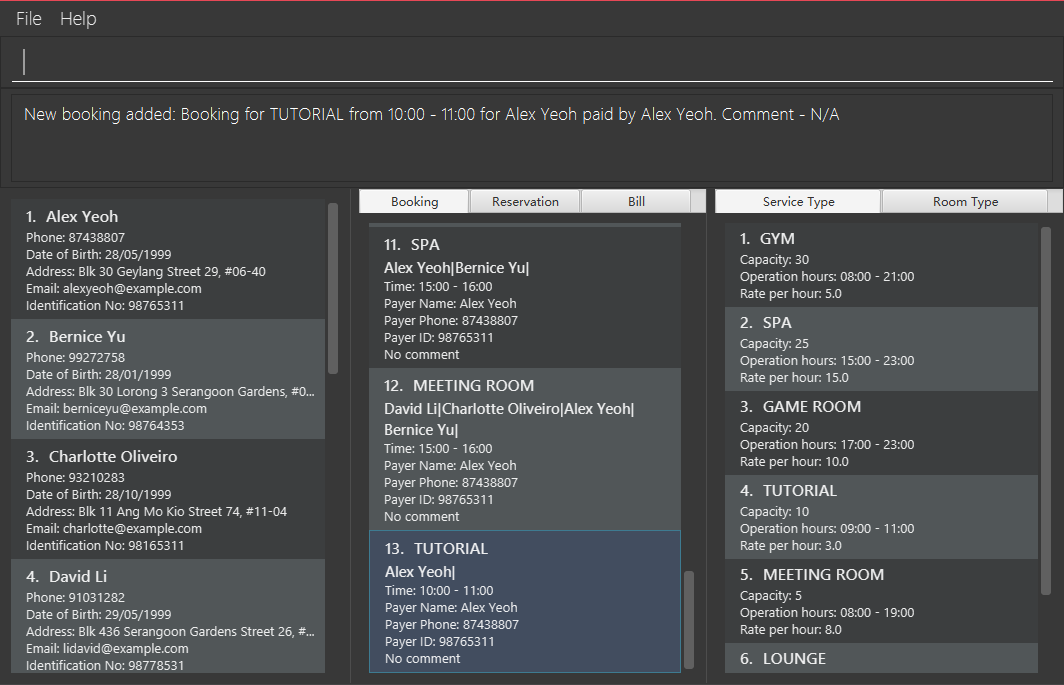
ab s/TUTORIAL :/10-11 $/1 command after executing3.17.3. Room Reservation
The reservation panel will be scrolled automatically to show the newly added item.
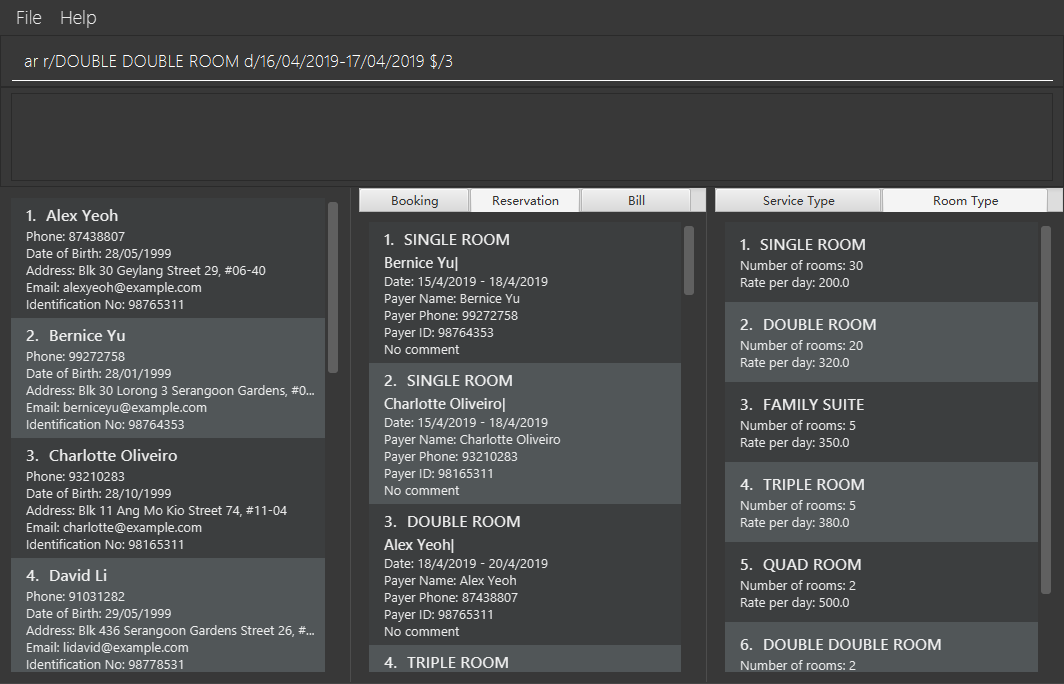
ar r/DOUBLE DOUBLE ROOM d/16/04/2019-17/04/2019 $/3 command before executing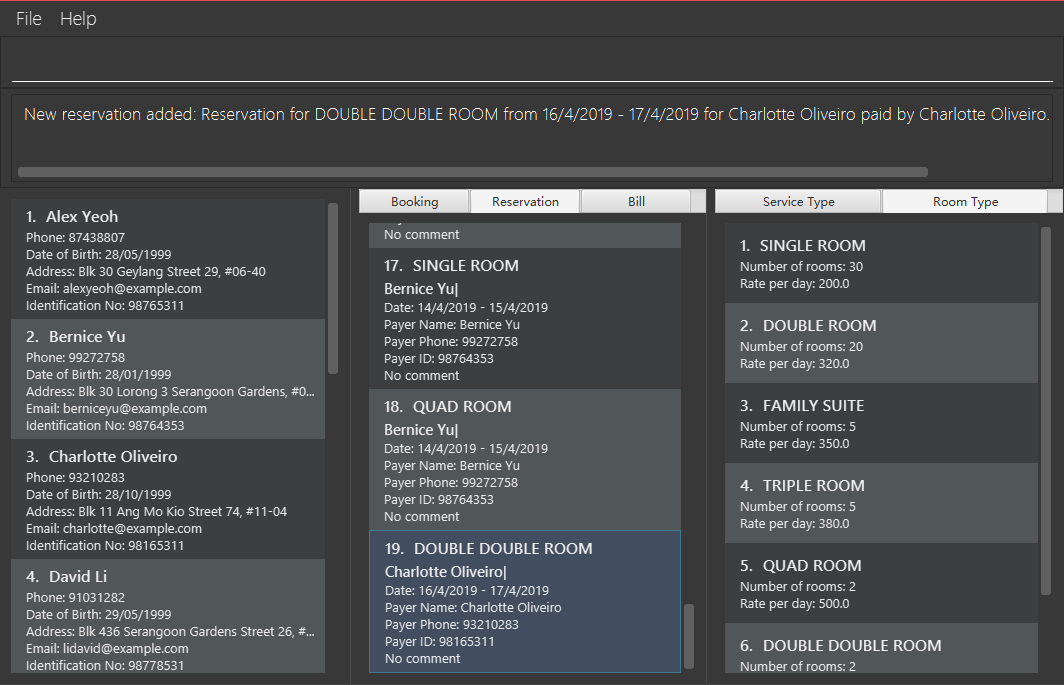
ar r/DOUBLE DOUBLE ROOM d/16/04/2019-17/04/2019 $/3 command after executing3.18. Filtering by clicking
3.18.1. Service Booking
Click on a service type and the booking list will be filtered by the clicked service type.
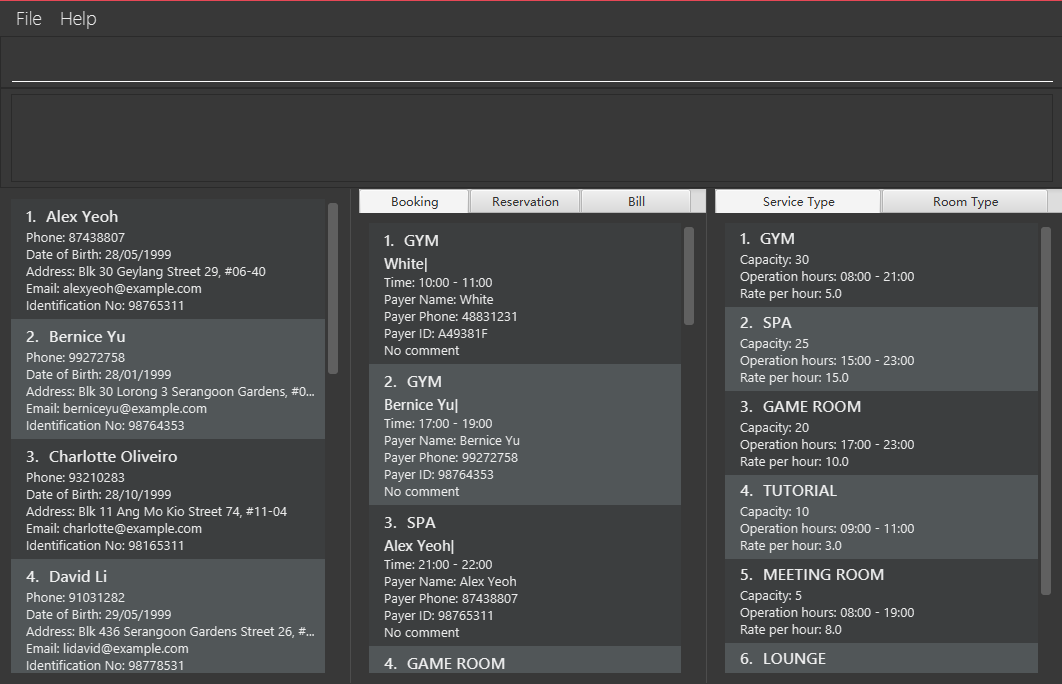
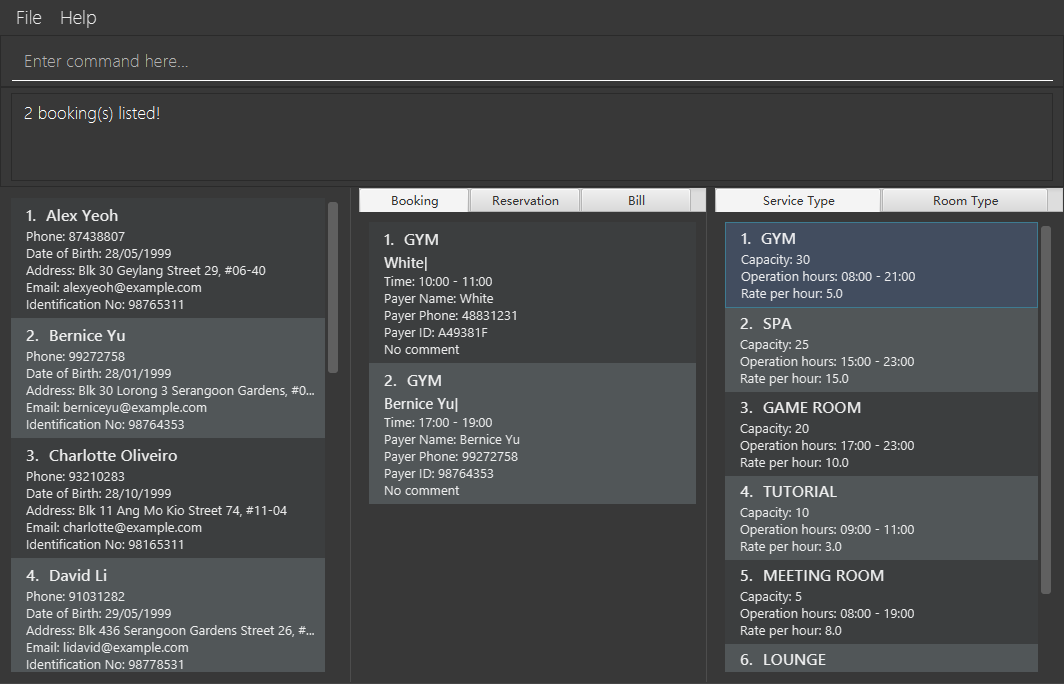
3.18.2. Room Reservation
Click on a service type and the booking list will be filtered by the clicked room type.


3.19. Saving the data
The HMS+ data file is saved in the hard disk automatically after any command that changes the data.
There is no need to save manually.
4. Prefix List
4.1. Customer
-
Name
- Prefix
-
n/ - Validation
-
Name should adhere to following constraints:
1: It cannot be blank. 2: It should only contain alphanumeric characters and space.
- Example
-
n/ Tejas Bhuwania
-
Phone
- Prefix
-
p/ - Validation
-
Phone should adhere to following constraints:
1: It should contain only digits. 2: It should be at least 3 digits long.
- Example
-
p/ 81424394
-
Email
- Prefix
-
e/ - Validation
-
Email should adhere to the following constraints:
1: Email should be of the format local-part@domain. 2: The local-part should only contain alphanumeric characters and these special characters, excluding the parentheses, (!#$%&'*+/=?`{|}~^.-). 3: This is followed by a '@' and then a domain name. The domain name must: - be at least 2 characters long - start and end with alphanumeric characters - consists alphanumeric characters, a period or hyphen for characters in between - Example
-
Identification Number
- Prefix
-
id/ - Validation
-
Identification Number should adhere to following constraints:
1: It should contain only digits and uppercase alphabetical letters. 2: It should be at least 7 digits long and maximum 10 digits long
- Example
-
id/ Z4264321
-
Date of Birth
- Prefix
-
dob/ - Validation
-
Date of Birth should adhere to the following constraints:
1: Date of birth should not exceed the current date. 2: Date of birth should be of the format: DD/MM/YYYY.
- Example
-
dob/ 28/05/1999
-
Address
- Prefix
-
a/ - Validation
-
Address has no constraints.
- Example
-
a/ 311, Ali Amar Avenue
-
Tag
- Prefix
-
t/ - Validation
-
Tag should adhere to following constraints:
1: Tags should be alphanumeric only.
- Example
-
t/ friend
4.2. Only Service Type
-
Operational Hours of Service
- Prefix
-
:/ - Validation
-
Operational Hours of Service should adhere to following constraints:
1: It should be between 0 - 23. 2: It should be of the format: HH - HH.
- Example
-
:/ 10-22
4.3. Both Service Type and Room Type
-
Name of Service or Room Type
- Prefix
-
n/ - Validation
-
Name should adhere to following constraints:
1: It cannot be blank. 2: It should only contain alphanumeric characters and space. 3: It can be maximum 20 in length.
- Example
-
n/ DOUBLE ROOM
-
Rate of Service or Room Type
- Prefix
-
rate/ - Validation
-
Rate should adhere to following constraints:
1: It should be positive.
- Example
-
rate/ 700.0
-
Capacity of Service or Number of Rooms
- Prefix
-
cap/ - Validation
-
Capacity should adhere to following constraints:
1: It should be positive.
- Example
-
rate/ 200
4.4. Only Service Booking
-
Service Type
- Prefix
-
s/ - Validation
-
Service Type should adhere to following constraints:
1: It should be a defined service type already present in the list.
- Example
-
s/ GYM
-
Timing of Service
- Prefix
-
:/ - Validation
-
Timing of Service adheres to following constraints:
1: The service timing should be within the operating hours. 2: If service type is full during that time, it returns an error message. 3: It should be of the format: HH - HH.
- Example
-
:/ 08 - 10
4.5. Only Room Reservation
-
Room Type
- Prefix
-
r/ - Validation
-
Room Type should adhere to following constraints:
1: It should be a defined room type already present in the list.
- Example
-
r/ SINGLE ROOM
-
Date of Reservation
- Prefix
-
d/ - Validation
-
Date of Reservation adheres to the following constraints:
1: If room type is full during those dates, it returns an error message. 2: It should be of the format: DD/MM/YYYY - DD/MM/YYYY. 3: It can only be from current date to one year after current date.
- Example
-
d/ 12/10/2019 - 14/12/2019
4.6. Both Service Booking and Room Reservation
-
Payer of Reservation or Service
- Prefix
-
$/ - Validation
-
Payer of Reservation should adhere to following constraints:
1: The index number should be valid.
- Example
-
$/ 1
-
Customers involved in Reservation or Service
- Prefix
-
c/ - Validation
-
Customers involved in Reservation or Service should adhere to following constraints:
1: The index number should be valid.
- Example
-
c/ 1
-
Comment for Reservation or Service
- Prefix
-
com/ - Validation
-
Comment for Reservation or Service should adhere to following constraints:
1: It shouldn't contain (/).
- Example
-
com/ Please turn AC on.
5. Command Summary
-
Help :
{help/hp} -
Add Customer :
{add-customer/ac} n/NAME p/PHONE_NUMBER e/EMAIL id/IDENTIFICATION_NO [a/ADDRESS] [dob/DATE_OF_BIRTH] [t/TAG]… -
List Customers :
{list-customers/lc} -
Edit Customer :
{edit-customer/ec} INDEX [n/NAME] [p/PHONE] [e/EMAIL] [id/IDENTIFICATION_NO] [a/ADDRESS] [t/TAG]… -
Find Customer by name :
{find-name/fn} KEYWORD [MORE_KEYWORDS] -
Delete Customer :
{delete-customer/dc} INDEX -
Add Room Type :
{add-room-type/art} n/ROOM_TYPE rate/RATE cap/NUMBER_OF_ROOM -
Delete Room Type :
{delete-room-type/drt} INDEX -
Edit Room Type :
{edit-room-type/ert} n/ROOM_TYPE rate/RATE cap/NUMBER_OF_ROOM -
Reserve room :
{add-reservation/ar} r/ROOM_TYPE d/START_DATE-END_DATE $/PAYER_INDEX [c/MORE_CUSTOMER_INDICIES…] [com/COMMENTS] -
List room reservations :
{list-reservations/lr} -
Edit room reservations :
{edit-reservation/er} INDEX [s/SERVICE_NAME] [:/START_TIME - END_TIME] [p/PAYER_INDEX] [c/MORE_CUSTOMER_INDICES] [com/COMMENTS] -
Delete room reservation :
{delete-reservation/dr} INDEX -
Add Service Type :
{add-service-type/ast} n/SERVICE_NAME rate/RATE cap/CAPACITY_OF_SERVICE:/OPERATIONAL_HOURS -
Delete Service Type :
{delete-service-type/dst} INDEX -
Edit Service Type :
{edit-service-type/est} n/SERVICE_NAME rate/RATE cap/CAPACITY_OF_SERVICE:/OPERATIONAL_HOURS -
Book services of hotel :
{add-booking/ab} `{add-booking/ab} s/SERVICE_NAME :/START_TIME-END_TIME $/PAYER_INDEX [c/MORE_CUSTOMER_INDICES] [com/COMMENTS] -
List services already booked :
{list-bookings/lb} -
Edit services already booked :
{edit-booking/eb} INDEX [s/SERVICE_NAME] [:/START_TIME# - END_TIME] [p/PAYER_INDEX] [c/MORE_CUSTOMER_INDICES] [com/COMMENTS] -
Delete service already booked :
{delete-booking/db} INDEX -
Finding a specific booking :
{find-booking/fb} [id/IDENTIFICATION_NO] [s/SERVICE_NAME] [:/START_TIME-END_TIME] -
Finding a specific reservation :
{find-reservation/fr} [id/IDENTIFICATION_NO] [r/ROOM_TYPE][d/START_DATE-END_DATE]` -
Generate bill for specific booking :
{generate-bill-booking/gb-b} INDEX [s/SERVICE_NAME] [:/START_TIME-END_TIME] -
Generate bill for specific reservation :
{generate-bill-reservation/gb-r} INDEX [r/ROOM_TYPE][d/START_DATE-END_DATE]` -
Generate bill for customer :
{generate-bill-customer/gb-c} INDEX -
Switch tab :
{switch-tab/st} PANEL_NUMBER TAB_NUMBER -
Select customer "
{select/s}INDEX -
History :
{history/hs} -
Undo :
{undo/u} -
Redo :
{redo/r} -
Clear hotel management system database :
{clear-hms/clear-all} -
Clear room reservations :
{clear-reservations/cr} -
Clear booked services :
{clear-bookings/cb} -
Clear room types :
{clear-room-type/crt} -
Clear service types :
{clear-service-type/cst} -
Exit :
{exit/ex}